
Bellwether THE NEWSMAGAZINE OF THE UNIVERSITY OF PENNSYLVANIA SCHOOL OF VETERINARY MEDICINE Bellwether THE NEWSMAGAZINE OF THE UNIVERSITY OF PENNSYLVANIA SCHOOL OF VETERINARY MEDICINE No.53 • Summer 2002 No.53 Summer 2002 Celebrating 50 Years of Veterinary Excellence at New Bolton Center Celebrating 50 Years of Veterinary Excellence at New Bolton Center

Dear Alumni and Friends:
We pause to celebrate five decades ofremarkable achievement since the University,in what appears to have been an act ofsublime optimism,purchased the 220 acre South Brook Farm with its elegant manor house and rickety barn,and bestowed it on the Veterinary School as the site for its large animal campus.In this half century,New Bolton Center has grown to comprise 687 acres and has acquired fame as “the world's premier equine clinic”,as the birth place ofequine orthopedic surgery,as the birth place ofthe first calfconceived by in vitro fertilization,and ofmany other accomplishments that are recorded on the pages ofthis anniversary edition of Bellwether
I am immensely proud ofNew Bolton Center,and as we pause to celebrate,can not help reflect on what it was that moved New Bolton Center to such accomplishment.The reason ofcourse was leadership,we have been blessed by it in abundance since Mark Allam first took hold ofthe reins in 1952.Napoleon once said that a leader is a dealer in hope.Mark was one ofthe world's greatest dealers in hope,his optimism was infectious and he was a genius at convincing his friends and acquaintances what needed to be done for New Bolton Center and then gaining their support.Mark set the foundations and gathered around him people ofextraordinary vision,Bob Marshak,David Detweiler,Jack McGrath,Charlie Raker,Dick McFeeley,Jacques Jenny, Charlie Reid,Bill Boucher,to name a few.Bob Marshak,a cultured cow doctor from Vermont,followed Mark as Dean.He was another extraordinary spinner ofhope and in 35 years oftheir combined leadership,New Bolton Center became a mecca for the profession.They inspired the faculty and an exceptionally dedicated and talented staff,with a whole new set ofideas and they raised the bar for veterinary medicine in this country and beyond.
Veterinary medicine has changed immeasurably in the past 50 years as has New Bolton Center.It remains a mecca,its reputation continues to expand and it is safe to say that the well-being ofthe horse would not be what it is today were it not for New Bolton Center.None ofthis could have occurred without the support of the Governor,the General Assembly ofPennsylvania,and the many individuals who have so generously and selflessly supported New Bolton Center for the past halfcentury.You have been incomparable! We thank all of you for your kindness and for the faith you have bestowed in us;we hope that you share our immense pride in New Bolton Center and our faith in its future.
Alan M.Kelly
The Gilbert S.Kahn Dean ofVeterinary Medicine


BELLWETHER 53 1
Bolton Farm was comprised of469 acres in Falsington,Bucks County.The farm with its Guernsey herd was bequeathed to the University by Effingham B.Morris upon his death in 1937. The farm was used for research by the School of Veterinary Medicine,the School ofMedicine,and the Department ofBiology.In 1952,when the area surrounding the farm was developed as Levittown and Fairless Hills,the University sold the property.


The University looks for a property in Chester County to relocate the farm and dairy herd. Early in 1952,during Dr.Raymond Kelser’s deanship,the 220-acre South Brook Farm is purchased from C.A. Higgins,president ofthe Hercules Powder Company.The main house, parts ofwhich date back to the early 18th century,had been renovated and enlarged by R.Brognard Oakie, a noted restoration architect. Theentire South Brook Farm building complex is listed on the National Register ofHistoric Places. In a news release ofMay 19,1952,the University states that the farm “will be used primarily for the clinical training ofsenior veterinary students and for the conduct ofscientific research,in particular the investigation ofdiseases with which farm animals are afflicted.”


During the summer of1952,the farm operation moves from Bucks County to Chester County.Over the years more land is acquired and today New Bolton Center encompasses 687 acres.

2 BELLWETHER 53
The manor house at South Book Farm.In the early days ofNew Bolton Center,it serves as a dormitory for students,offices for faculty,and a library.It is the heart ofthe new campus.
Dean Raymond Kelser who dies in April 1952.
Dr.Mark W.Allam,V’32, is appointed acting dean upon Dr.Kelser’s sudden death.
Two cement block buildings are constructed,near the barn.The 5,000 square foot space accommodates an exam room,surgery, recovery stall, pharmacy, diagnostic laboratory,and four research laboratories. The buildings are still in use by the Center for Animal Health and Productivity

In 1953,the School’s Field Service,supervised by Dr.William Boucher,V’40,relocates from Media to the Chester County farm.That same year the School creates a Department ofMedicine and Hygiene based at New Bolton Center.The poultry diagnostic laboratory opens under the direction ofDr.George Sperling.




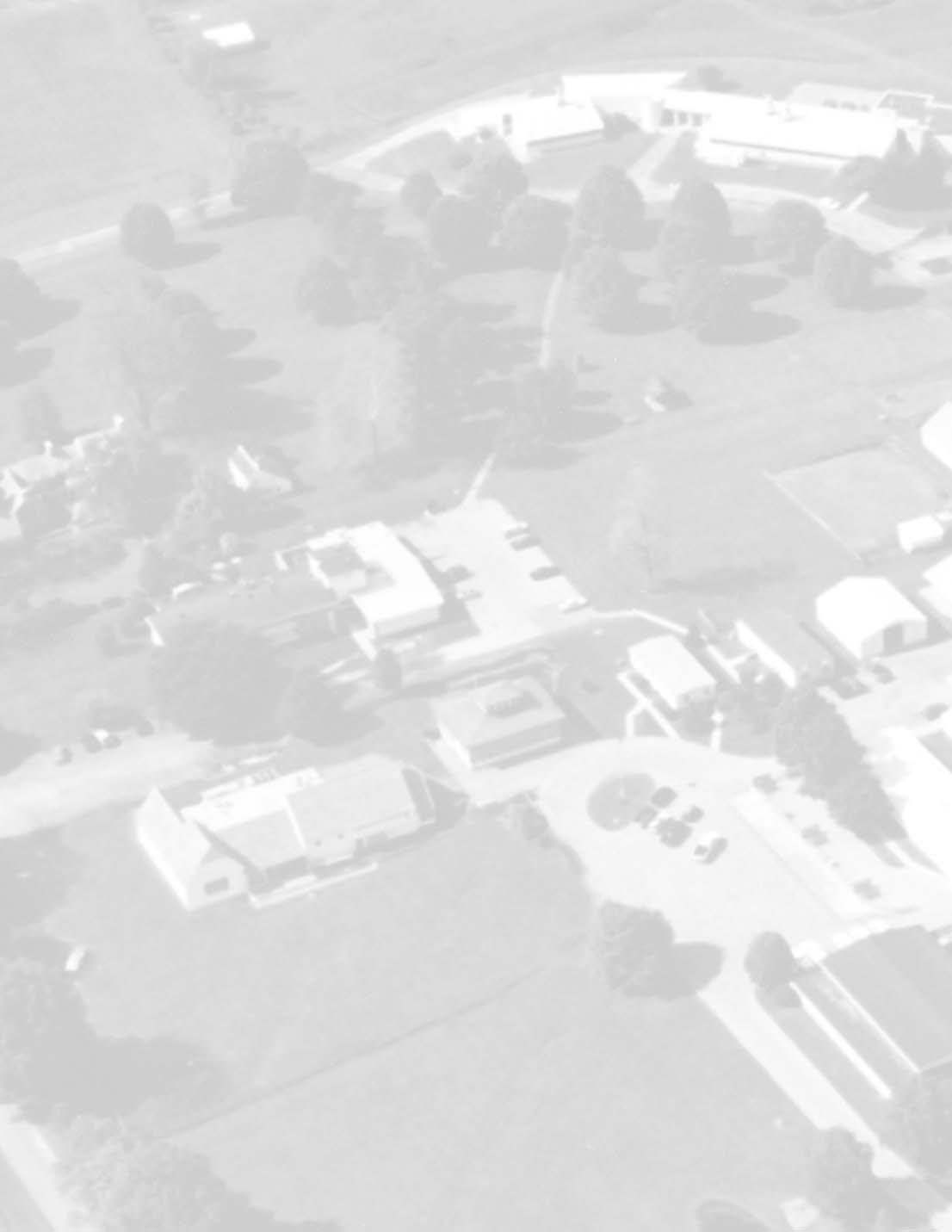
BELLWETHER 53 3
Inthe late summer of1962, “First Night Concerts”are held on the terrace ofAllam House.A string quartet, members ofthe Philadelphia Orchestra,performs for an audience ofcommunity members and New Bolton Center staff– it is an outreach program arranged by Dean Allam to bring the Center and the community together.
Mastitis Research Laboratories in

Building, dedicated in 1962 in memory ofDr.Murphy.The building is still used today as offices for members ofthe Department ofPathobiology.


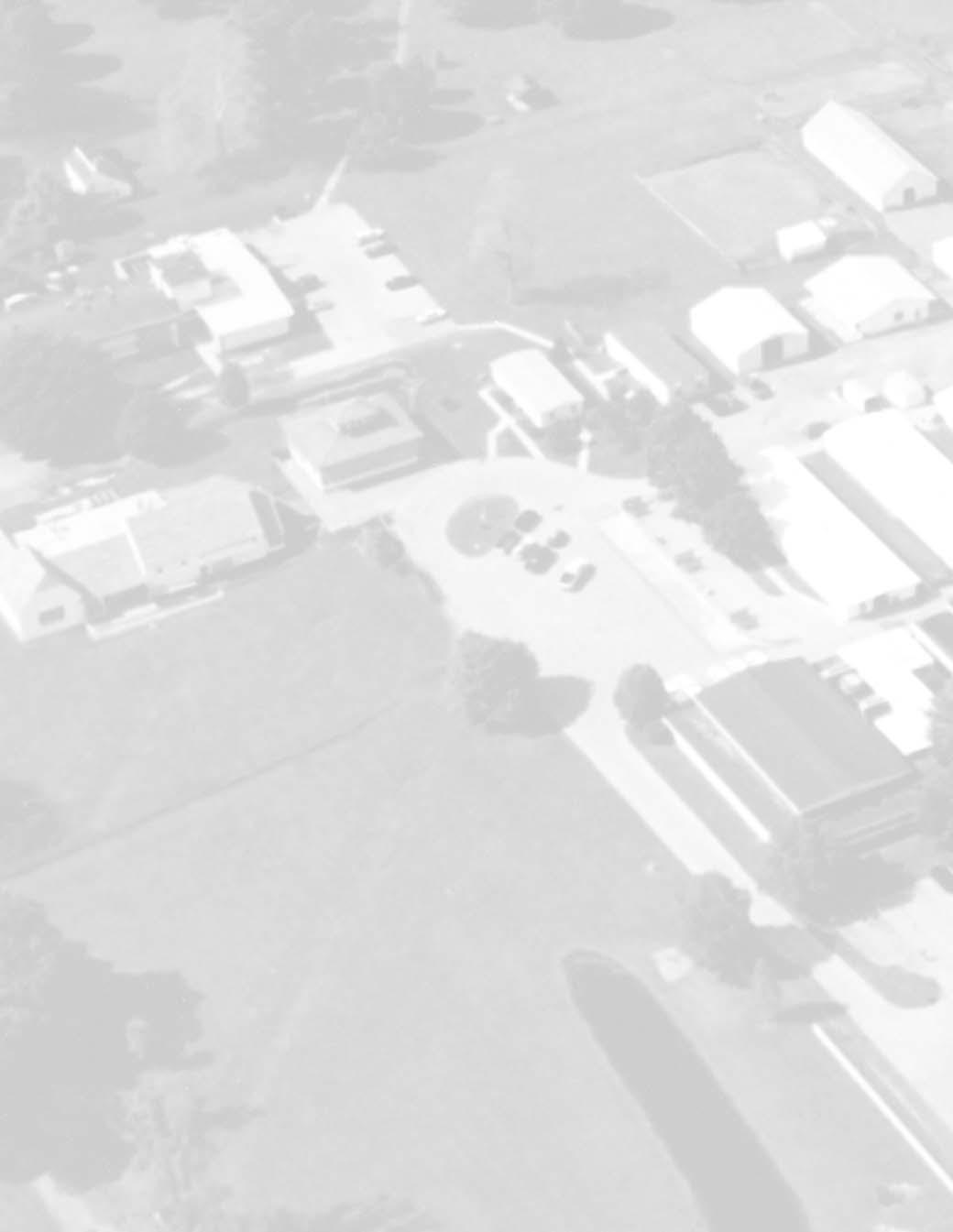
4 BELLWETHER 53
Hospital construction site as it looks on June 6,1962.
the James MacMillan Murphy Research
On September 26,1961,ground breaking ceremonies are held at New Bolton Center for the Hospital and Large Animal Clinic and for the Dormitory-Conference Center.The distinguished diggers shown here are (l to r) Lawrence B.Sheppard, Clark W.Davis, Mrs.Charles E. Mather II, Dr.Ernest C.Deubler,V’11, Mrs.E.K.Tingley, Dr.Joseph W.Vansant, Mrs.Richard C.duPont, Dr.Robert L.Ticehurst,V’34, Dr.Benjamin Price, and Crawford C.Madeira.
In 1963,the Comparative Leukemia Studies Unit is established under the direction of Dr.Robert R.Marshak who joined the faculty in 1956.The work on bovine leukemia had begun in the late 1950s,with the identification and characterization ofdairy cattle herds in which leukemia cases were occurring.The National Cancer Institute awards funds for construction ofa bovine leukemia research facility and for acquisition ofa Jersey jerd with an exceptionally high incidence ofleukemia. Drs.Donald Abt,V’61, and Douglas C.D.Hare are leading members ofthe research team.


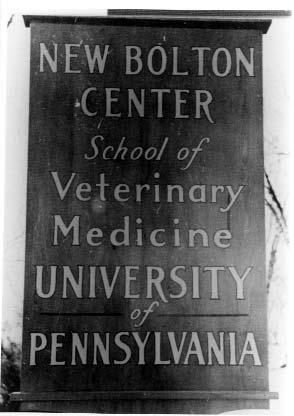
In the 1970s,under the direction of Dr.Jorge Ferrer,researchers at the Comparative Leukemia Studies Unit identify and characterize the bovine leukemia virus.
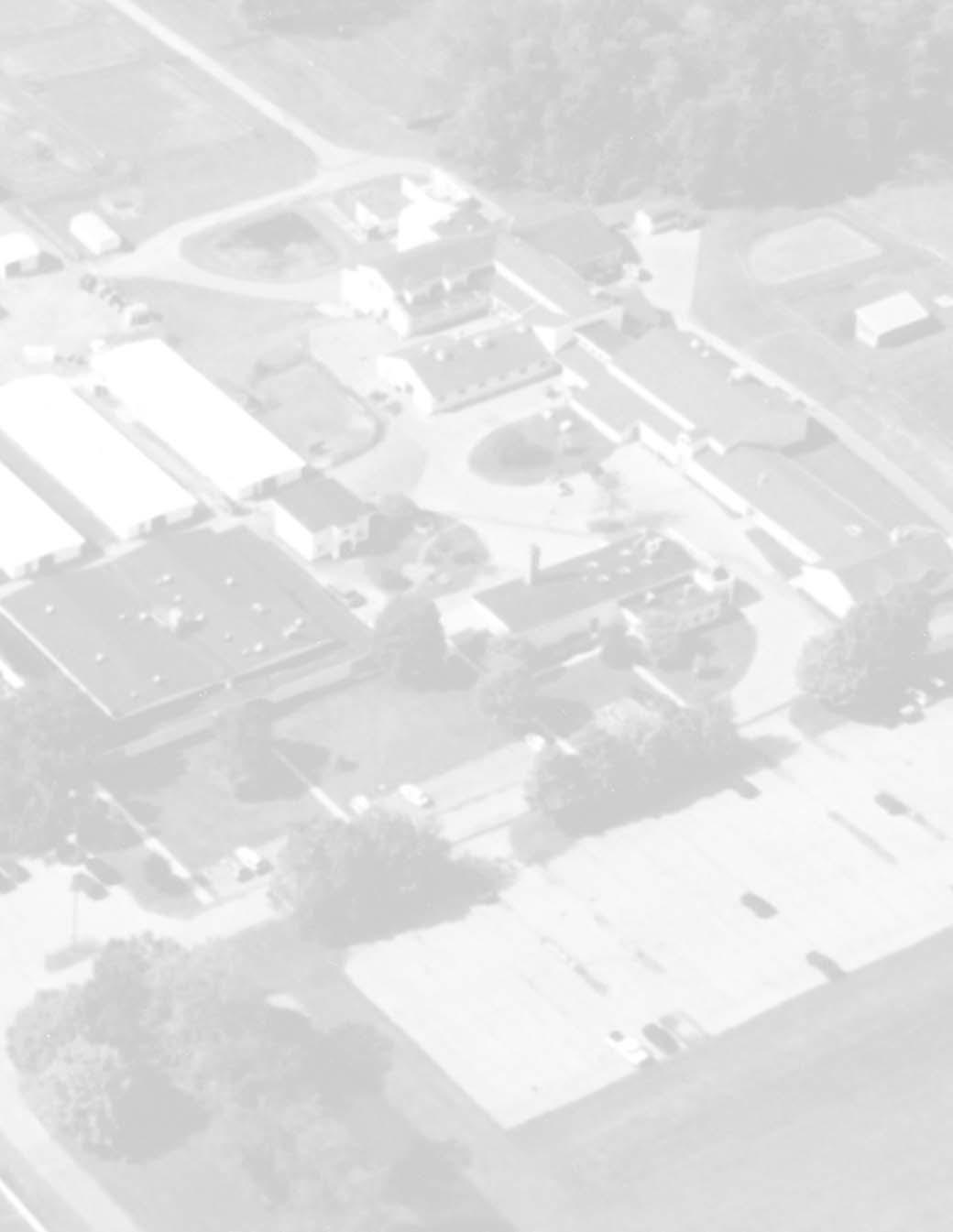
BELLWETHER 53 5
The Hospital and Clinic for Large Animals, dedicated in 1964.The cost ofthe building is $900,000.At the time ofthe dedication, $830,000 has been raised from private donations.The hospital has a general surgery and special surgery suites.In the latter,the operating table moves on rails,weighs 3,000 lbs.and can be tilted.The custom-designed table can accommodate a 1,000 lb.animal.




6 BELLWETHER 53
General Surgery.
Mary Ruth Hammond,ORnurse.
The barns at New Bolton Center are built with the help ofa construction crew from Hanover Shoe Farms, kindly provided by Lawrence Sheppard.Toward the end of the construction,unions threaten to picket the University over the non-union laborers used in building the barns.The Hanover Shoe Farms crew is withdrawn and the barns are finished by union workers.The four buildings can accommodate 24 bovine and 45 equine patients.





BELLWETHER 53 7
The Alumni House and Vansant Dormitory,dedicated in 1965.The cost ofthe building is $340,000.
Cafeteria in the Alumni House – it hasn’t changed much.
Dr.Jacques Jenny and Lawrence B.Sheppard.
In 1968,through a bequest,Mr.Sheppard endows the Lawrence Baker Sheppard Professor ofSurgery at the School.It is the first ever endowed chair in any veterinary school.Dr.Charles Raker,V’42,is named the first Lawrence Baker Sheppard Professor ofSurgery.


The Allam House is the site for many important social and fundraising events.Shown here in 1968 are Dr.Luther Terry,former U.S.surgeon general, Mrs.Allam, and Mr.Graham French.
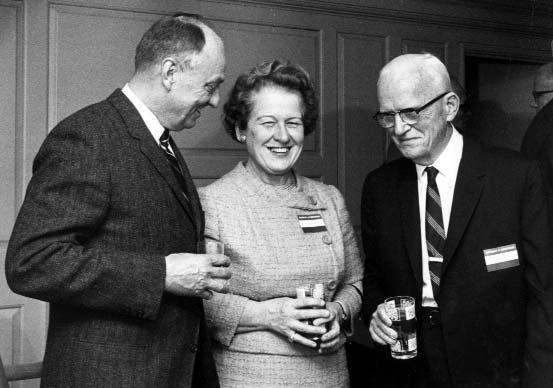
Jewel,an elephant from a small circus,is brought to New Bolton Center for treatment ofa leg injury. She is kept in a sand paddock normally occupied by injured horses.

8 BELLWETHER 53
Dr.Raker teaching.
The Hofmanns make frequent visits to New Bolton Center,often arriving by helicopter. Here it is used for travel to Maryland,l to r, Lila Allam, Gay Robinson, Jacques and Eleanor Jenny and Georgia Hofmann



Dedication ofthe Georgia and Philip Hofmann Center for Animal Reproduction. Shown here are Dean Mark Allam, Gaylord Harnwell, president, University ofPennsylvania, Mrs.Hofmann and Mr.Hofmann

Dr.Robert Kenney and the Hofmanns with one oftheir horses. Georgia and Philip Hofmann, both avid horse enthusiasts,had a long standing relationship with the School.Philip Hofmann served on the School’s Board ofOverseers and was chairman for a number ofyears.
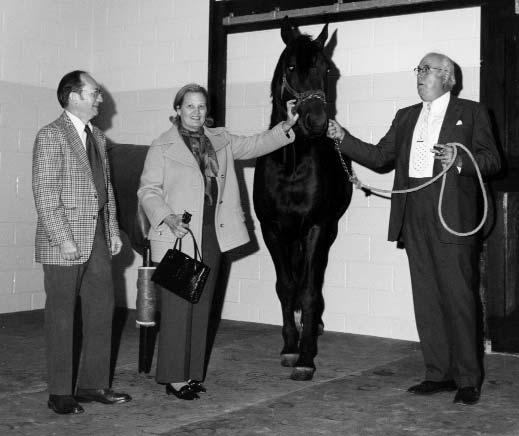
BELLWETHER 53 9
The Hofmann Center.
The Alarick Myrin Memorial Research Building dedicated in 1973.Initially,the building contains research laboratories, the Jean Austin duPont Library and the Moran Surgical Suite.Now the building is home to the toxicology laboratory, the library,and the Center for Animal Transgenesis and Germ Cell Research



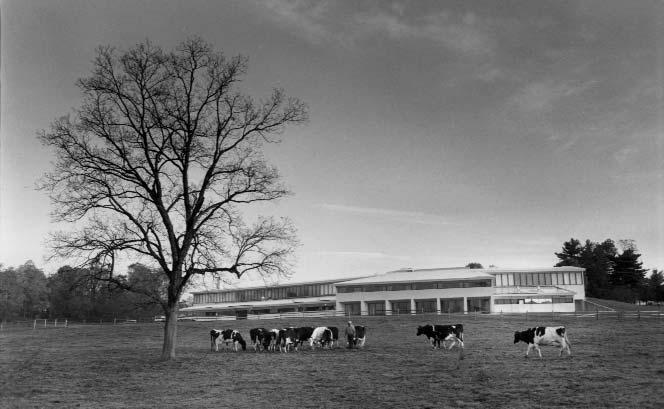

10 BELLWETHER 53
The Jean AustinduPont Library
Alice Holton,longtime librarian.
Mark W.Allam retires in 1973 and Robert R.Marshak is appointed dean.
TheC.Mahlon Kline Orthopedic and Rehabilitation Center was conceived by Jacques Jenny,considered the father oflarge animal orthopedic surgery. Dr.Jenny envisioned a facility where complicated fractures could be repaired and where the animal could emerge from anesthesia without injuring itself. To that end,the operating room is equipped with a monorail that runs from the recovery stalls through the OR to the pool area and then to stalls in the adjacent barn and Intensive Care Unit. The pool walls are recessed.When a horse emerges from anesthesia its natural reaction is panic and flight, leading to dangerous thrashing of limbs and possible re-injury.In the pool in the waterproofraft,it can move its legs and body without encountering a solid surface,thus preventing reinjury.Once awake the horse is hoisted from the raft and moved to the recovery stall where it can stand at once.New Bolton Center surgeons recover horses in the pool about 50 times each year –pool recovery has been invaluable for many patients.





BELLWETHER 53 11
C.Mahlon Kline Center.
Dr.Jenny who served on the faculty from 1948 until his death in 1971.
The operating room showing the adjustable table and the monorail.
Construction ofthe C.Mahlon Kline Orthopedic and Rehabilitation Center.






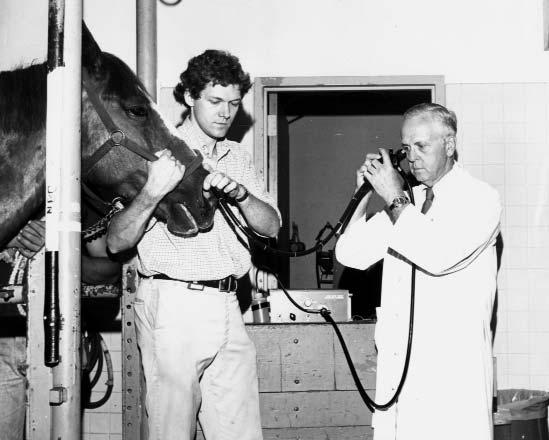
12 BELLWETHER 53
Dr.Lin V.Klein,V’70.
A horse being lifted from the recovery pool.
George Pournaras,regarded as one of the hospital’s most gifted anesthesia technicians by Dr.Raker.
Operating room in the Kline Center.
Dr.Loren Evans.
Dr.Raker uses a flexible endoscope.
June 14,1979 is the first “New Bolton Center Day at Belmont Park.”Faculty members Loren Evans, Richard A.McFeely,V’61,Charles Raker and Monica Reynolds are available to answer horse owners’and trainers’questions during a reception and luncheon. “New BoltonCenter Day at Belmont”is held every year until 1983.





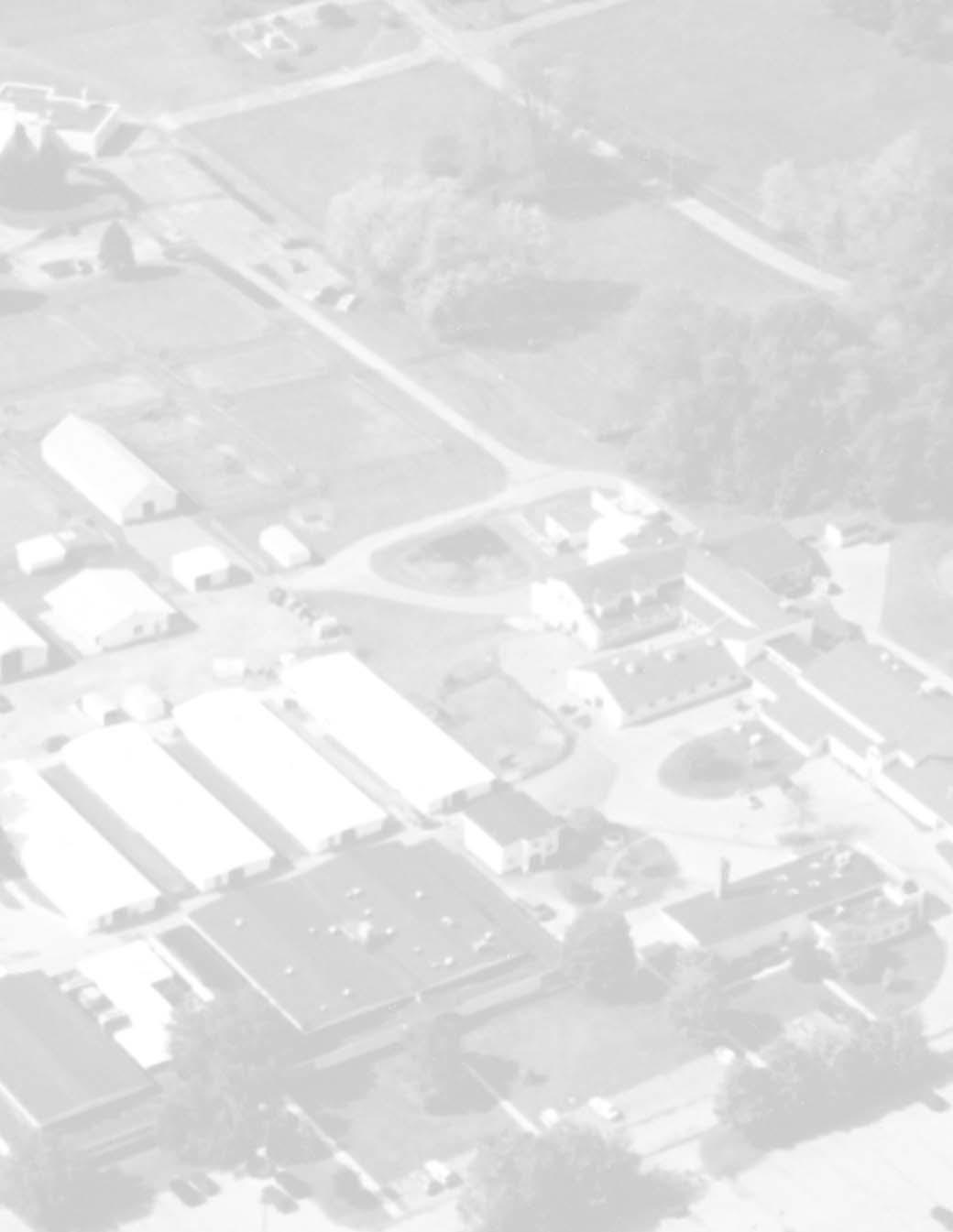
BELLWETHER 53 13
In 1977, David George Jones and his wife Marion Dilley Jones establish The Allam House Fund to support and maintain the historic house.Shown here are Dr.Mark Allam and Mr.Jones.
Dean Robert Marshak, Mark Allam and Charles Raker with the New Bolton Center blanket awarded to the winner ofthe Belmont New Bolton Center Race in 1983.
The swine facility on Bird Road,it opened in 1979.
The radiology equipment in the hospital in the late 1970s.
The equipment today
The need for more teaching space, outpatient clinic and offices in the Hospital and Clinic for Large Animals is recognized.The construction ofthe addition begins in the late 1970s.



Theenlarged hospital is dedicated and renamed the George D.Widener Hospital for Large Animals in honor ofMr. Widener.The renovations were made possible by a $1,050,000 gift from the Trustees ofthe Estate ofGeorge D.Widener.

Alarge number of guests attend the dedication ceremony

14 BELLWETHER 53
University President Martin Meyerson and F.Eugene Dixon,Jr., chairman ofthe Trustees ofthe Estate ofGeorge D.Widener.
Foundation digging for the addition.
Mr.Vincent B.Murphy,Jr.,member of the School’s Board ofOverseers,and Mrs.J.Maxwell Moran
The additions to the hospital.





BELLWETHER 53 15
Mrs.David Rockefeller and Mrs.Vincent Murphy.
Mrs.Joan F.Pew, Mrs.David Banks,members ofthe School’s Board ofOverseers,and Mr.Charles Wolf, chairman ofthe Board ofOverseers.
Mrs.Samuel F.duPont, Dr.Raker, Almira and Hardie Scott
Mrs.Grace Lambert.
team,headed by Dr. BenjaminBrackett,performed an in vitro fertilization.The fertilized egg was then implanted into a recipient cow and normal pregnancy followed.This work had significant impact on embryo transfer in livestock production.

Aresearch

The animal reproduction team in 1981. Standing:unknown, Bruce Laidig, Richard McFeely, Paul Strzemienski, Benjamin Brackett, Mark Cahoun, Marolo Garcia;second row: Lynne Klunder, John Hurtgen, Larue Manning; first row:unknown, Margie Cummings, Tracy Higgins, Daniel Bousquet, Debbie Fowler, Robert Kenney, Buddy Dreisbach
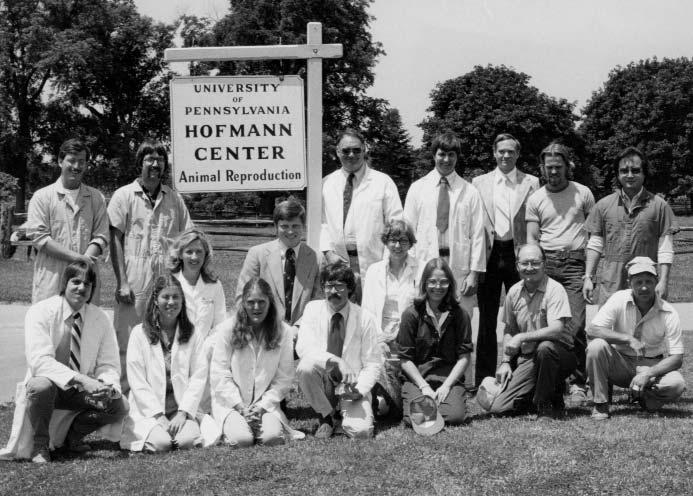
16 BELLWETHER 53
Virgil, the first test tube calf,and his surrogate dam.Virgil is born at New Bolton Center on June 9,1981.
In 1975, Dr.John T.Alexander uses the arthroscope for diagnostic purposes. He is the first veterinarian to apply this technology to veterinary medicine. His efforts are ridiculed by many in the profession.


In 1982, Dean Richardson begins using arthroscopy therapeutically.Today it is a common procedure for the removal of floating material from the joints of horses. Some arthroscopic procedures are even done routinely in standing horses, reducing the hospitalization and recovery time.

In the 1980s,New Bolton Center establishes a dedicated nursing staff. The nurses contribute to teaching and patient care. Today no one can imagine the hospital without its professional nursing staff.


BELLWETHER 53 17
Barry Haines.
Dr.David Kronfeld conducts extensive nutrition studies for food animals and working sled dogs.
Dr.Thomas Divers develops parenteral nutrition to treat very young calves with bovine viral diarrhea.Others contributing to the projects are Drs.David T. Galligan,V’81, Thomas Hansen and Raymond Sweeney,V’82

In 1983,the Poultry Diagnostic Laboratory identifies a virulent form ofavian influenza in Pennsylvania.This is the second time such a virulent virus strain appears in Pennsylvania chickens.The first was in the 1920s when Dr.Evan Stubbs,V’11,identified the virus.



18 BELLWETHER 53
Dr.Robert Whitlock and an equine patient.
Dr.Virginia Reef implants a pacemaker into Bucky,a horse with heart rhythm disturbances.Bucky and Dr.Reefcompete at the 1984 Devon Horse Show.
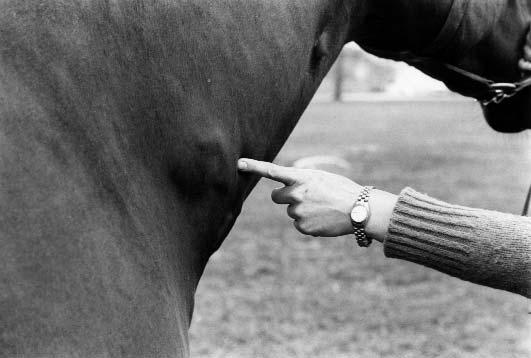

Around 1982, Dr.David M.Nunamaker,V’68, develops and begins to use an external fixator to stabilize a horse’s leg after repair ofa complicated fracture.Shown here is an early version. The device received a patent in 1986,and was repatented in 1996.



Drs.Moyer and Nunamaker receive the largest grant in Thoroughbred Racing history from the New York division ofthe Horsemen’s Benevolent and Protection Association to study bucked shins and its relationship to racing/training surfaces.

BELLWETHER 53 19
Dr.David Nunamaker.
Site ofthe pacemaker.
Dr.William A.Moyer.

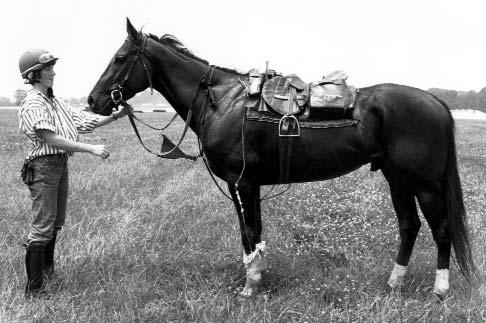



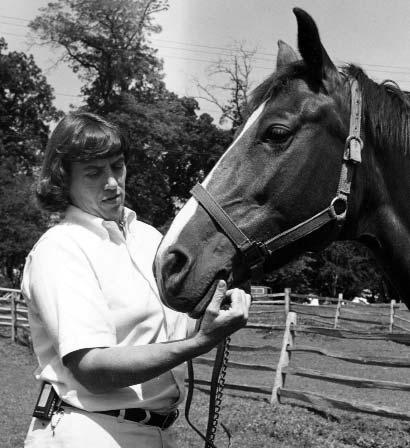

20 BELLWETHER 53
A horse in the bucked shin study outfitted with monitoring devices.
Dr.Wendy E.Vaala,V’80, and a foal in the hospital’s first neonatal ICU.The unit was established in one of the barns in 1984.
Another NICU patient.
The William B.Boucher Field Service Building is constructed in 1985.
Dr.Elaine P.Hammell,V’60.
Dr.Richard Bartholomew.
“Ripley’s Believe It or Not”films at New Bolton; Marie Osmond narrates the segment about plate luting – it takes 10 hours and a crew of30 to produce 2 minutes ofprogramming.


Diagnostic ultrasound comes to New Bolton Center in 1985. Dr.Virginia Reef uses the diagnostic modality for cardiology patients and patients with suspected tendon problems. Dr.Reefhas become a foremost expert in the application ofdiagnostic ultrasound.



BELLWETHER 53 21
Dr.Benson B.Martin,Jr.,V’80,teaching.
Dr.Colin Johnstone and students.
EarlyDays
By David A. Meirs II, V.M.D., V’54
Our class (’54) was probably the last class to visit Bolton Farm,near Bristol.We went there as freshman in the spring on 1951,primarily to learn how to caponize chickens.This farm was later sold for development and the proceeds used to purchase New Bolton in Chester County. I have a number ofmemories ofNew Bolton Center.Unfortunately only a few ofthese have anything to do with veterinary medicine.In the early years New Bolton Center bore almost no resemblance to what it later became.The school did not wish to offend neighboring private practitioners by becoming a competitor so the only cases we got were referrals.In fact I can only recall one such case,a horse with botulism. The horse was referred to New Bolton and remained recumbent until it expired or was put down a few days later.We students provided nursing care in shifts around the clock.Care consisted mostly ofturning the animal from side to side at regular intervals.
What was later named the Allam House was our dormitory and cafeteria.There were not many other buildings.Aside from a functioning dairy herd ofabout 40 cows,there were few large animals there.Upon these we practiced passing stomach tubes and catheters,casting with ropes,etc.There was also a poultry necropsy facility in which we participated.
Dr.Raker had recently joined the faculty after several years in a mixed practice.He had yet to establish his world-class reputation as an equine surgeon.What limited equine surgeries the school did were still performed in Philadelphia.New Bolton did not even have a large animal surgery table!
Since there was so little to do,we passed the time playing very physical touch football on the Allam House lawn (Dr.Boucher was a terror)! Afternoons and evenings we read or played cards and/or drank prodigious quantities of beer and sang.
One day after lunch Dr.Raker appeared and
New Bolton Center – Thoughts from the First Class
New Bolton in the fall of1952 was pastoral and pristine depending on your upbringing.To those ofagrarian setting,it was pastoral to a fault,to those ofurban lineage,pristine beyond comprehension.What is now dubbed “Allam House”was the focal point offirst impression. There was little else.A barn to the rear with a bit ofan attachment that served as the poultry laboratory ofthe State ofPennsylvania,a small outbuilding to the left ofthe main entrance and to the right a home structure for the farm manager in residence.Then several miles to the rear another barn,which housed the resident cattle herd,recollection says,Guernseys.And many acres ofprime Chester County farmland, yet to be properly assessed and/or developed, surrounded the whole estate.
Staffing such an enterprise must have been gargantuan for there were few bodies to spare. Funding has always been a problem at the University ofPennsylvania,and New Bolton was no exception.Dr.Tom DeMott served as the manager in residence and Dr.George Sperling held forth in the poultry lab.Occasional visits by Drs.Boucher and Laudenslager filled out our tutelage.There were our two field services led by Drs.Maurice Arnold and James McCahon who,in all honesty,were the only two preceptors to whom we had any real exposure.It was,possibly,from these two superior
asked for any suggestions we might have for some meaningful activity that afternoon.Dairy was then my primary interest,and I asked ifwe could collect semen from the bull.Dr.Raker thought this a splendid idea so offthe dairy we trouped.Here we learned about proper preparation ofthe artificial vagina (A.V.).Since this whole thing was my idea,I was assigned the honor ofactually making the collection.Now although I was quite familiar with artificial insemination ofcattle,I had never seen a bull breed.I had no idea with what alacrity the typical male bovine accomplishes this pleasant task. I positioned myselfexpectantly,A.V.in hand,at the proper slot along the chute just behind the cow. The bull tore down the chute like a rocket and brushed me out ofthe way as I stood there completely flabbergasted.He bred the cow in an instant and sauntered back to his pen, accompanied by gales oflaughter from my classmates.
By Jefferies Hathaway,V’53
clinicians from private practice that we received the bulk ofour clinical experience,and on the road,one could say.When one mentions staff, it would be an oversight to not mention our secretary/receptionist,Mrs.Owens,long suffering she was,and those two delightful people who served as cooks and bottle washers,Mr. and Mrs.Claude Ellis.
Our formal education was derived from wildly driven trips with Drs.Arnold and McCahon,the occasional visits from Drs. Boucher and Bartenslager during which we ravaged the Guernseys at the nearby University barns with pregnancy exams to the point that these brave bovines bellowed blatantly as we approached.Dr.Charles Raker,a mere slip ofa fellow in those days,would stop by to take us on a stable call,dipping down into “Chateau Country”ofDelaware,since there were no horses here at that time.Much ofthe rest of our academic day was given to writing up the calls made on field service trips,and /or trips to the library to read,reread,and read again,the few books we were thoughtful enough to bring from Philadelphia.
Our informal education centered on daily chats with Dr.Sperling,(when it was determined that chickens weren’t high on our list of endeavors [until too late,ofcourse].These chats involved the take over ofCuba by Fidel,
the McCarthy fiascoes,the probable beginning ofthe Eisenhower period,and whether the “Whiz Kids”were really over the hill.They were! Otherwise time was spent in winters with pinochle,bridge,and hearts in front ofthat fabulous walk-in fireplace,and in spring with chipping golfballs in the back lawn,with the occasional errant shot sent through a window ofthe office.Evenings would occasionally find us hard at play with shuffleboard at the “Tick Tock Club”between the lanes north ofKennett Square.What was really nice was that on the weekends our wives came out to visit.They were billeted in the same luxurious quarters that we occupied on the second floor of“Allam House.”Many ofus had never seen such opulent quarters as these! Walk-in closets with built-in drawers and cupboards.Marvelous!
And from these beginnings issued forth some ofthe finest and locally revered large animal practitioners ever to serve the farms of Pennsylvania,shirt and tie under the overalls, gum boots,pail and brush in hand.Ready and able! Witness these names:Earl Blackburn,Max Brubaker,Hugh Coleman,Amos Hollister, Harold Landis,Elmer Marx,Earl Neufer,Bob Probasco,Sam Rice and Jim Thompson. Pennsylvanians!
Presented by and for the Class of1953, fiftieth reunion next year,2003.
22 BELLWETHER 53
New Bolton Center Recollections
Soon after the University acquired New Bolton Center,a fourth year veterinary student, a city-bred kid beginning his rotation in the Poultry Diagnostic Service,raced up to the manor house* where Dr.George Sperling was savoring his morning coffee and announced breathlessly that there’s a rabbi with a sick chicken in the diagnostic lab.It seems this was the student’s first encounter with the Amish, but it was also one ofhis few encounters with a sick farm animal ofany species.
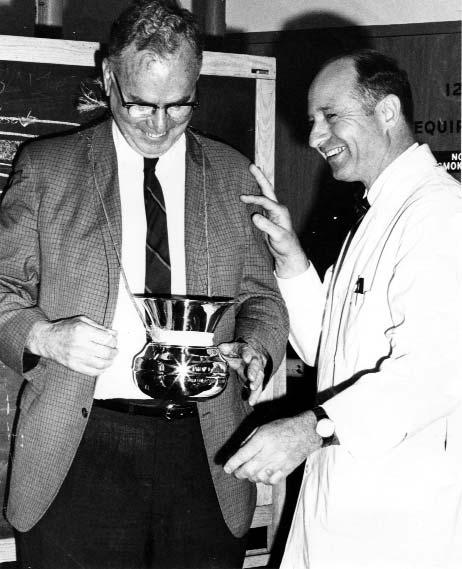
When I arrived at the Veterinary School forty-six years ago,students were openly cynical about their clinical training at New Bolton Center.The large animal rotation was regarded as a kind ofcountry club rest and recreational experience in lovely southern Chester County, with room and board in the gracious,historic manor house.There were few faculty,teaching facilities were primitive,and primary access to ailing farm animals had been relinquished to preceptors in private practice,or in the case of horses,to the Equine Clinic on the School’s Philadelphia campus.An agreement with local practitioners prohibited farm calls by faculty and students.Cases were accepted solely as referrals,an arrangement that failed abysmally to meet the School’s minimal teaching and research needs.Ifthere was a saving grace,it resided in the person ofDr.William Boucher, the Center’s Medical Service Chief,a brilliant diagnostician whose ability to mine pedagogical riches from the sparsely available case material was legendary.Regularly inviting students to his home,Bill dispensed knowledge,wisdom,and tough love while his wife,Doris,dispensed motherly love and delicious homebaked cakes and cookies.
My first awareness ofNew Bolton Center was on a workday evening in 1956,when Dean Mark Allam phoned to invite me to take a brief respite from dairy cattle practice in Vermont to be interviewed for a faculty position in medicine,and especially to visit the School’s large animal campus,a unique facility,according to Mark,located in the heart ofPennsylvania dairy farm country.This was pretty heady stuff for a small-town cow doctor,and I swallowed the bait.
I deplaned from an ancient DC-3 in Philadelphia on a blistering August afternoon. Sensing my distress,Mark guided me to an airport bar for what turned out to be a memorable series ofdry martinis.I recollect a feeling ofcortical release as we drove into Philadelphia for what Mark described as a preliminary tour ofthe School’s
By Robert R.Marshak,D.V.M.
City campus,meaning a quick look at the Old Quad Building on 39th and Woodland.It occurred to me afterwards that my positive first impression ofthe antediluvian,poorly maintained Quad was more than a momentary lapse in judgment.Mark Allam was a spellbinding charmer,and ofcourse the martinis contributed their bit to my sanguinity.
Early next morning,after an old-fashioned Philadelphia breakfast – my first taste of scrapple – we set out to visit New Bolton Center.During a leisurely drive with many detours,Mark described his hair-raising ride to Kennett Square with University President Harold Stassen,whose Quixotic quest for the nation’s highest office was to make him the subject offrequent ridicule.After a perfunctory examination ofthe 220-acre Higgin’s estate on West Street Road,Stassen approved its purchase for the School’s large animal campus.The year was 1952.
At Longwood Gardens, a few miles east ofNew Bolton Center,Mark and I had our first substantive discussion about the condition ofthe School and about the state ofveterinary medical education in general.As we talked on, with a growing sense of excitement,I began to grasp the dimensions of Mark’s vision for the future.I found myself succumbing to the beliefthat Penn’s Veterinary School,despite its impoverished condition, could indeed become a national leader.The timing was propitious.After WW2 and Sputnik the federal government had committed to vastly increased funding for biomedical education and research.The venue was favorable.The School was linked administratively,academically,and geographically to a leading academic health center,and a cadre ofyoung,gifted, adventurous,intensely loyal faculty,who shared the dean’s vision and energy,was on board. There was a chance at Penn – I could almost taste it – to move veterinary education,especially clinical education,out ofits traditionally vocational mode,and to catch-up with our colleagues in human medicine.It seemed a cause worthy ofany sacrifice,and I remember thinking that ifthe medicine position were offered,I would seize it regardless ofsalary.
Three months later,I moved my family to Wallingford,Pennsylvania,a suburban community approximately equidistant from Penn’s main campus and New Bolton Center.My halcyon days in Vermont had ended as I was propelled abruptly into the unfamiliar,competitive,turbulent,fascinating,intellectually exciting,often frustrating,and sometimes heartbreaking world ofacademe.
Despite the School’s impecunious circumstances relative to other schools ofveterinary medicine – I recall pleading for a supply of University stationary from the dean’s fiercely territorial administrative assistant – I never doubted that the ideas and initiatives I had discussed with Mark and a few faculty colleagues were more than illusory musings.
A huge food animal industry was potentially at risk and we were the Commonwealth’s only veterinary school.Moreover, an affordable food supply,food safety,and diseases transmissible from animals to man were issues ofconcern to consumers and to public health officials.Hence,to justify increased State support it was imperative to begin at once to develop or expand services and research programs that consumers,farm organizations,the profession,and the executive and legislative branches ofstate government would recognize as necessary and beneficial.
To gain name recognition,to make known the School’s goals and achievements,and to befriend important individuals,particularly those in leadership positions,Mark Allam became a regular presence in Harrisburg and at dinners and meetings offarm and breed organizations,farm shows,the Pennsylvania Grange, and at Republican and Democratic fundraising affairs.I marveled at his ability each year to ingest at least thrice his weight in chicken,roast beef,mashed potatoes,green peas,ice cream,and apple pie,without seeming to gain an ounce.His charm,energy,and enthusiasm, and the ability to recall names and faces were extraordinary.His efforts brought the School, and particularly New Bolton Center,the recognition and respect that would help to secure its future.
BELLWETHER 53 23
* Now known as Allam House continued on page 25
With Love from Texas
By William Moyer,D.V.M.
I should have known New Bolton Center was halfa century old,but somehow in my life and career I’ve always thought it was just “there”.The positive influence New Bolton Center has had over these many decades is incredible and worldwide.It is particularly noticeable here at Texas A&M.Our “equine program”,I believe,is an excellent one and I think that is the case because we have exceptional faculty,including folks like Drs.Martens, Varner,Blanchard,Hinrichs,Love,Cohen, Marsh and me (I like to picture myselfas a contributor).Guess where we were all trained? New Bolton Center – and the folks who made it what it is and will always be is – for me personally – the equine veterinary “head waters”.
However, I didn’t always know or think that. My exposure to New Bolton Center was initially in the spring of’69.Dr.O.R.Adams,at Colorado State,found out I was heading east as both my wife and I had family back there.He suggested (for those ofyou who actually knew O.R.,it was hardly a suggestion) that I try to spend my summer months at the University of Pennsylvania.You have to understand that I didn’t know that Pennsylvania even had a vet school,or ifthey had one,surely it must be at Penn State.
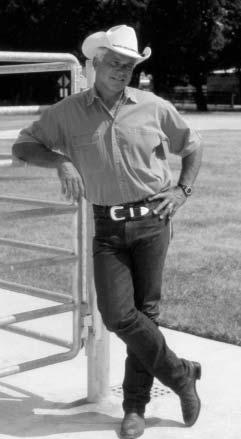
In any case,I initially hooked up with Dr. Loren Evans and was welcomed to come as a guest.It never dawned on me to ask where the place was,simply because I figured it had to be at the University ofPennsylvania.So I loaded my stuff,eventually found Philadelphia,and even made it to the campus.Now I sure hope I don’t hurt anybody’s feelings,but for a person basically raised in northeast New Mexico and southwest Colorado,West Philadelphia for me had that “Beirut War Zone”look.It took lots ofcircling,time,and ‘near death’experiences to find a place to park my pick-up and make my way to what seemed like the front door (I never did determine ify’all have a front door).I then asked somebody where I could find either Dr.Evans or Dr.Charles Raker.No-one in that part ofthe building knew who those people were,and I was beginning to think that I would be better off heading back west.I finally found an older gentleman,explained my deal,and eventually, through the laughter,he told me I was thirtyodd miles east ofwhere I should have been.
I got lost several times trying to find Route One and then Kennett Square.I also found it interesting that most ofthe folks in Kennett Square did not know where New Bolton Center was.This two thousand mile trip was looking more and more like a bad deal.I finally found Route 926 and New Bolton Center’s white fence and lovely sign.I could not believe the size and
beauty ofthe place and the surrounding country. I met Shirley Poole at the front desk and was introduced to Dr.Evans.Dr.Evans spoke pretty clearly;that is,as opposed to the foreign dialect I got when asking for directions in Philly.Eventually he introduced me to Dr. Charles W.Raker,the head man,THE CHIEF.
I will always remember my first introduction to Dr.Raker.He was sitting behind his desk with a neat pile ofcase records,smoking a pipe and wearing one ofthose “pork pie”cloth hats.He also had on a white lab coat,tan pants with black socks,shoes (no boots) and a white shirt with a tie.This was definitely not my image ofa big time “horse doctor”.The faculty at Colorado State in those days, especially O.R.Adams,could have easily been stand-ins for a John Wayne movie – so this was a very different look.But Dr.Raker could not have been any nicer and told me how to find a room at the student dorm.
On the way to the cafeteria I met Roy Bergman,Bob Vallance and Lee Bach,along with Jim Stewart (a resident at that time) – all names that have made their mark on veterinary medicine.That afternoon I got some greens and scrubbed in with two students and Dr.Raker; and also met George Pournaris,a New Bolton Center legend.We did two “knees”and alter in the day a standing “roarer”.This was one more knee than I had seen in a whole year at Colorado State and my first ever “Raker version”(finger nail dissection) ofa Hobday operation.
The barns were packed the entire summer; Jack Anderson was shoeing and teaching in his shop,Jim Rooney was performing in Necropsy, Dr.Jacques Jenny had several ofus up some nights trying to save a broken-legged horse,Dr. Charlie Reid was asking me ifColorado State had gotten round to purchasing an x-ray machine,and colics were coming at a fast clip most nights.The level and amount ofwork that occurred daily far exceeded what I had been exposed to at Colorado State.
I also very clearly remember not knowing very much about horses,especially horses on the East Coast.One afternoon I was on with Jim Stewart looking at a horse with what seemed to me a very subtle problem.He was discussing the history with the husband while the wife cantered around the field,and he said
the horse “had trouble changing his leads.”I had to ask Bob Vallance what a “lead”was – I had no earthly idea.Plus,as I watched with others this horse canter (I’m assuming I have the correct term) around I could not understand why anyone would drive all that way (from New York state,ifI recall) to have a horse looked at who could move that fast and was not lame.“Lame”in Colorado State was defined as “having not touched the ground with a given foot in the last three days.”Lameness diagnosis consisted basically offiguring out which leg had the wire wrapped around it.This Land ofNew Bolton was definitely different than the world I came from.I also learned that horses were cooled out by walking in circles for what I thought was a real long time,and some actually wore what seemed to be a leather football helmet when they shipped,and everything got bandaged (even tails).
The wonderful part ofmy New Bolton Center experience was that all kinds of people were always around for me to ask questions of, without that horrible feeling ofbeing a giant fool.Dr. Raker treated us students like we were in his practice,we were not just students,we were his colleagues.For me that was a great life lesson. Dr.Evans every Thursday afternoon showed us all kinds ofpalpation ideas,where to block and inject,and a bazillion stories to go with each anatomic area.Dr.Jim Rooney could cut up a horse faster than most butchers,and to this day I have yet to see another pathologist literally take horses apart to that degree ofcompleteness.He could also entertain in rounds and most all the clinicians attended – it was wonderful.Mr.Jack Anderson was without a doubt the best horse shoer in the world at that time; he was also amongst one ofthe finest and most accomplished teachers.He’d come in after hours and show whoever wanted to learn how to bang on iron.These were two ofthe most cherished months out ofmy life that I will never forget.By the end ofthe summer I was very much better prepared for my last year at Colorado State.New Bolton Center and the wonderful folks that were there changed my life.
For reasons unknown to me I was accepted as an intern the following year;that sure must have been an interesting discussion when my name
24 BELLWETHER 53
came up.My years as an intern and resident put me in touch with clinicians like John Alexander, Bob Kenney,Dick McFeely,Dick Bartholomew, Elaine Hammel,Bill Donawick and a life long friend,Al Merritt (I can still see his head bobbing up and down in rounds when he agreed on something).Students like Jill Beech,Midge Leitch,Mary Bell,Cathy Kohn,Steve Soule,Doug Antczak,Scott Palmer,Harry Werner and Jack Bloom – the list oftheir names goes on and on, as well as their many accomplishments.Living in the little house next to Harnwell Pond and being exposed to New Bolton Center for three years was simply wonderful.
From that point my direction was into private practice,just down the road from New Bolton Center for seven years,and then back to
New Bolton Center Recollections
Mark Allam was also quick to appreciate New Bolton Center’s advantage over other veterinary schools in geographic proximity to concentrations ofquality horse breeding and racing operations in New York,New Jersey, Pennsylvania and other mid-Atlantic states.He understood that excellent medical care would motivate horse owners to contribute generously to equine research and to the development of New Bolton’s physical facilities.It was,therefore,extremely fortunate that Dr.Charles Raker,and his colleagues,most notably Dr. Jacques Jenny,had already established Penn’s reputation in the equine field.
Dr.Raker achieved renown as an equine surgeon during ten years as Head ofthe large animal service in Philadelphia.Students ofthat era will remember the Old Quad Hospital with its carnival-like atmosphere:trucks,trailers, vans unloading horses,cows,swine;grooms and students exercising horses and dogs around sodden,pitted Huidekoper Field.The gloomy stables were survivors ofa time when the City’s commerce moved no faster than a trot.The high box stalls with their noble occupants were bedded deep with straw,and iron posts topped with brass balls bestowed an apt touch ofelegance.Just west ofthe antiquated operating theater the clinic hall with its worn red brick floor,soak stalls and casting mats served as the main teaching and treatment area.
Over this sprawling,tumultuous scene, Charlie Raker presided with a steady,determined hand.He moved between the OR, stable,office,lecture hall,and conference room at a near gallop;popping in one door and out another:operating,teaching,consulting,writing,conferencing – a study in disciplined
NBC.My nearly thirteen years (1980 to 1993) at New Bolton Center were great.I got to work with referring veterinarians like Drs.Ernest Stearly,Ed Mersky and Jim Borthwick – they sure made it easy because they were always kind enough to “cover up”all my mistakes.
It was great fun working with Rob Sigafoos, who is the most creative farrier I’ve been around.I suspect between the two ofus we tried just bout every combination ofdesign and materials to stick on horses’feet that one could imagine.Rob is a household name in horse shoeing,even in the Republic ofTexas! But I must admit that my most easily brought up set ofvisuals is Charlie Raker snapping his surgical gloves,Jack Anderson working at a coal forge,Rob Sigafoos covered up in soot and
continued from page 23
motion.His stamina was matched by an exceptional surgical talent and keen intellect.He had a strong aversion to anything false or pretentious.
In that extraordinary decade ofthe Raker Era,the scope,quality,and success rate of equine surgery at Penn improved remarkably, and the Old Quad began to attract top quality horses.The waiting list for elective surgery grew alarmingly long,overwhelming the Old Quad’s facilities and personnel.So in 1964, when the new large animal hospital at New Bolton Center finally opened its doors, Charlie Raker was the obvious choice to take charge ofthe equine service.
With facilities and personnel now appropriately matched, equine surgery soon reached the high standard ofhuman and canine surgery as an academic discipline and,in the process, Penn earned its reputation as the best place in the world to bring an equine patient for surgical care.The rate and magnitude ofthe change in the sweep and sophistication ofhorse surgery can probably be appreciated only by those privileged to have worked in close association with Charles Raker and Jacques Jenny and their small circle ofdisciples,Bill Donawick,Loren Evans,Bill Moyer, and David Nunamaker,to name a few.
glue,and the legendary Jill Beech’s office.The good news is that when I visited last summer (2001) she had the same “stick’um”note on her microscope (often wondered ifthe light source had ever been turned on) that was there when I came to Texas in 1993.Lots ofthings have changed in the three decades since I first went there,but some things rightfully stay the same.
The name “New Bolton Center”in the horse world stands for excellence in teaching and innovation,and remains the court oflast resort for many.In our world it is analogous to names like “Secretariat”,the New York Yankees,the Mayo Clinic and (ofcourse) Texas.Happy Birthday, New Bolton Center,from a very grateful son.
In my collection ofmemorabilia there is a photograph I particularly treasure.I am standing between Charlie Raker and Bill Boucher, beloved colleagues,major contributors to the Veterinary School’s great leap forward.
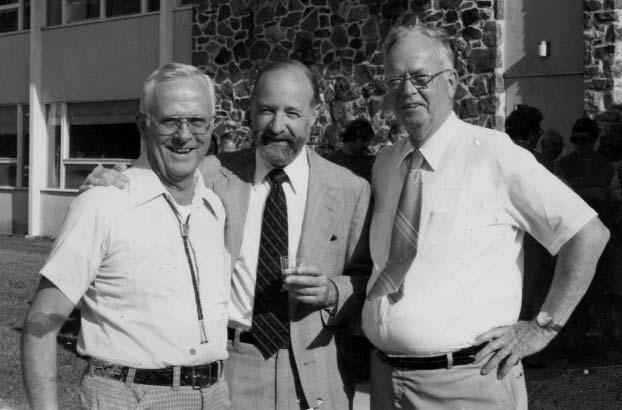
I first met Bill at a dinner party at the dean’s house in Media during my initial visit as a candidate for a faculty position.Ifhired,I would be Bill’s boss,a circumstance that didn’t seem to thrill him.Bill’s Boss.Could there be a more perfect oxymoron?
At the time,I assumed that anyone who
disagreed with my strongly held views on veterinary medical education must,a priori,be at least a closet anti-intellectual.I figured that our paths were destined to diverge in unpleasant ways,especially because I planned to locate my office,for starters,in Philadelphia instead of New Bolton Center where Bill was an assistant professor assigned to Field Service.Eventually,I
continued on page 26
BELLWETHER 53 25
Personal Snapshots of the Early Years
As a teenager working on a Bucks County dairy farm I was taken to visit the original Bolton Farm.My chiefmemory was ofhorse stalls in the old barn that were completely screened from insects.This was part ofa research project on equine infectious anemia and although I didn’t realize it at the time,it helped to whet my appetite for veterinary medical research.
My first trip to New Bolton Center was in the fall of1957 as a freshman student.As part ofDr.Tom DeMott’s class in animal husbandry we were actually going out to see some real chickens instead oflearning the various breeds from photographs.Up to that point recognition was based on what the birds were doing in the photograph rather than what they looked like.Fifty years later I still remember that white Wyandotts had two standing and one pecking. We learned how to bleed chickens that afternoon.It was the first and last time I ever did it.
As senior students,we spent two six week blocks at the Center.We lived dormitory style in what was to become the VIP suite ofthe Allam House.Dr Boucher commuted daily
By Richard A.McFeely,V’61
from his home in Media and woe be it to the student who wasn’t hard at patient care when he walked into the barn in the morning.My group ofeight was made up primarily ofveterans who were slightly less intimidated by the “Big B”than some ofour classmates.We soon learned that we could linger over coffee ifwe posted a lookout in the dormitory with a view ofthe main gate.When Dr Boucher’s Rambler appeared at the entrance,the alarm was sounded and a short dash across the lawn assured us ofbeing “in place”on time.
During these NBC blocks,two students were assigned to weekend duty.While during the week faculty,staffand students,ate lunch together in the lower dining room,no service was available on the weekends.However,food was left in a refrigerator and could be cooked on a hot plate.Most chose to revert to more primitive times and many a steak was cooked over the open fire in the huge fireplace in the log room.Beverages were kept cool in the large copper kettle,which hangs in one end ofthe room.While memory tells me that it was filled with sodas and lemonade,I could be mistaken
about this.I remember that lunches were usually soup and a sandwich and the cost was $0.35.
There was also an unlimited supply of peanut butter and jelly,
When I returned to NBC on a full-time basis as a post-doc in the mid 60’s,things had changed.The hospital was in full swing and there was now a dormitory and a proper cafeteria.In an attempt at self-improvement,the younger interns,residents,graduate students and post-docs met periodically to discuss a predetermined subject,often with a senior faculty discussion leader.As noble as these efforts were, not infrequently the discussion turned to a complaint session.The group called itselfthe Mushroom Club because we claimed to be kept in the dark and fed nothing but horse manure.
In the late 1960’s the Section ofClinical Reproduction had acquired a Holsteiner stallion named Herkules as a gift from Mr.and Mrs.Philip Hofmann.Dean Allam had also convinced Mr.Hofmann to provide a stable for Herkules.It soon became evident that an addition to the stable including a clinic hall,labora-
would come to know that Bill simply distrusted people whom he thought aspired to administrative positions,to exercise control over others.
I can’t exactly say when I began to appreciate that Bill’s presence was a formidable asset, and that just beneath the surface ofhis stern, independent,somewhat intimidating demeanor was a truly kindred spirit.I discovered that we shared many ideas about clinical education,and that Bill was inflexibly attached to first principles.Because he was so deeply respected,his unstinting support,for what at the time was perceived by some as my radical agenda,helped to assure its acceptance and ultimate success.For a School and profession in transition,Bill served as a bridge between two eras.A clinician whose exceptional diagnostic skills were based in the main on accurate history taking and thorough physical examination, he nevertheless wholeheartedly embraced and promoted the shift to a more science-based curriculum,and he shared my passion for developing clinical specialties and for training more veterinarian-scientists.
As one ofthe School’s most revered teachers,Bill transformed the outlook,and sometimes the lives,ofmany who came under his influence.In his celebrated Saturday morning Grand Rounds,which regularly attracted stu-
dents from all four classes,the discourse was intense and exciting.With everyone focused on the patient,Bill’s rounds had a compelling real life quality that students loved.Student presenters knew that nothing but the best was expected ofthem,that Bill sought imaginative ideas as well as practical knowledge.And though he never allowed himselfto ridicule the weaker among them,he was quick to show his distaste for the slothful or the bogus.On occasion, when a student or clinician he disliked trippedup in rounds,something akin to a smile would brighten his countenance like a blue light in a refrigerator.
One ofour fondest dreams for New Bolton Center,so distant from Penn’s main campus, and sometimes succumbing to a them-againstus field station mentality,was a greater basic science presence.Bill shared my conviction that clinicians would benefit from a richer intellectual environment and would welcome ready access to the latest techniques and equipment, and to opportunities for collaboration so readily available to their clinical colleagues in our Philadelphia.I had hoped that the Comparative Retrovirus Research Unit,where Dr.Jorge Ferrer, a brilliant tumor immunologist,and his colleagues were unraveling the mysteries ofthe bovine leukemia virus system,would provide a
model for such collaboration.For many reasons this never quite worked out,but I am heartened,as I know Bill would have been,by the presence at New Bolton ofa thriving Center for Animal Transgenesis and Germ Cell Research,directed by Dr.Hans Schöler,and also by the numbers ofclinical faculty – Dean Richardson,Tom Parsons and Ray Sweeney are good examples – whose rigorous scientific training has established them as productive independent investigators.
Throughout our years together as faculty colleagues,Bill had remained self-sufficient, proudly independent.So when he called it quits,suffering from steadily worsening Parkinson’s,I wondered how well he would endure the sudden silence ofretirement.He rejected my plea to continue his famous bull sessions with students and to accept a modest stipend. He wouldn’t hear ofit,nor would he state clearly his reasons for refusing.But reading between the lines,I’m sure he believed that the School wouldn’t be getting its money’s worth. He refused to compromise his rigorous standards,however slightly,despite the certain knowledge that,as his disease progressed,his financial circumstances would worsen.
This imperfect tribute to Bill calls to mind a remark he made to me after we had attended
26 BELLWETHER 53
New Bolton Center Recollections continued from page 25
tory,office and breeding shed was essential.Mr. Hofmann again came through with the funds. In order to save money,Dean Allam appointed me to design the facility,put it out for bids and oversee the project.As it had to be a union shop doing the construction,the building was built from plans drawn on a poster board with a magic marker by a local asphalt paving contractor who also happened to employ a couple ofcarpenters.Thanks to the dedication and common sense ofall the contractors and subs who worked on the project,it came in on time,on budget and,most importantly,it functioned as intended – surely a first in my experience with a University construction project.I can’t imagine a
dean getting away with that today. As August of1977 approached,several ofus decided to have a 25th Anniversary party and invite our neighbors and local merchants and trades people who had served us so well during our first quarter century.A chicken barbecue was planned.Dr.Bob Eckroade,poultry pathologist, was placed in charge ofthe food with the caveat that we could not use chickens from his laboratory.Barry Haines and his maintenance crew built the barbecue pit,Bill Garmon constructed the three racks used in cooking the birds and Leroy Bruce and others made up the invitation list.Courtney Michener who supplied our fertilizer agreed to bring his barbershop quartet and provide

entertainment.A 4’by 8’cake was made and decorated with many scenes from around the Center.All was proceeding well until about an hour before the party was to begin.At that point a sudden storm blew up and the heavens opened up.Despite efforts to circle the fire with hay wagons and draping tarps,the fire was extinguished.Water accumulated in the parking lot outside the cafeteria that was knee deep at one point.In my 39 years at the University,I have never seen as much rain before or since. However, we finished the chicken in the ovens, the cake somehow got moved undercover and everyone got fed in good order.As we finished dinner,the sun came out,the water receded, the music played and the singers sang.The party was considered to be a great success.The legacy ofthat day – the barbecue pit – remains as an important center ofsocial activities, although it now has a permanent roof.No one knows exactly how many chickens have been cooked over that pit but it certainly exceeds 10,000 and the number continues to grow.
some particularly interesting case presentations at the Medical School.Reflecting on their complexity and on what he regarded as the then relatively primitive state oflarge animal practice,he said something like,I spend all ofmy days pursuing a goal that is always receding. And so indeed he did,this wholly civilized, good,and scrupulous man.
The transformation ofNew Bolton Center from impoverished country club to world leader in a mere five decades did not come easily.Costly mistakes were made along the way, insufficient funding was a chronic problem, and tough decisions sometimes had unpleasant unforeseen consequences.
My decision to abandon the private practitioner preceptor program in favor ofan independent school-based Field Service was made when it was clearly evident that the referral system,at approximately one case per week,would never provide sufficient animals for teaching or research.Moreover,the system surrendered control ofthe students’clinical training – a fundamental faculty responsibility – to practitioners with no supervision or oversight.The decision did not go down well with a few local practitioners who,in a stormy meeting, denounced the School administration as an enemy ofprivate enterprise who aimed to run
them out ofbusiness.One practitioner actually lobbied in Harrisburg to deny us our small,but critically important,State appropriation.When after many months things quieted down,it was apparent that no local veterinarian lacked in clientele.Indeed,new practitioners moved into the area,enjoying the advantages ofNew Bolton Center’s many accessible resources.
There were other painful episodes,as when Dr.Robert Kenney,a man ofimmense integrity and one ofthe nation’s most distinguished specialists in theriogenology – that ghastly arcane word for the veterinary equivalent ofobstetrics/gynecology – having invested heavily in the training and subsequent appointment to the staffoftwo recent graduates for the purpose of establishing academically important programs in bovine embryo transfer and in equine reproductive management,was stunned,as I was, when they abruptly resigned from the School to set-up local private practices,taking our clientele with them.To this day,my gorge rises when I recall this disloyal,venal behavior.
As the land mass ofthe New Bolton campus increased to more than 687 acres through the acquisition ofadjacent farmland,and as new clinical and research facilities and Centers were added,there was exponential growth in the numbers ofprofessors,instructors,lecturers,
residents,interns,visiting academics,nurses, grooms,and technicians.In such a diverse and complex community,with many egos competing for position,resources,cases,and space, some level ofdiscord was inevitable.Mostly it was short-lived and manageable,staunched by a shared commitment to the School’s mission and a generally pervasive feeling ofrespect and admiration for one’s colleagues.Occasionally, quarrels erupted and metastasized,damaging programs and individuals,and even interfering with efforts to recruit candidates for open positions.Though there are countless examples throughout human history,the harm and pain that one or two malevolent individuals can inflict upon an institution or community continues to astonish me.
But as I grow old and look back at my thirty-seven years at Penn,good memories,like a soothing balm,far outweigh the bad.IfI were free to choose a legacy,it would be the extraordinary colleagues – most with reputations that far exceed mine – I had a hand in recruiting, mentoring,advancing,retaining,and sometimes losing to fine sister institutions.To name them all,to tell their wonderfully unique stories,would require more than a single issue of Bellwether, and I would be terrified to inadvertently exclude even one deserving individual.
BELLWETHER 53 27
Dr.Robert Eckroade.
Rendering ofthe ICU. This is the finest building anywhere designed specifically for the critical care of large animals.



Ground is broken for the Connelly Intensive Care Unit/Graham French Neonatal Section in 1985. Christine Connelly and Anne Thorington break the ground while Charles Wolf,chairman of the School’s Board ofOverseers,and Dean Marshak look on.

28 BELLWETHER 53
Construction ofthe ICU.
Dean Edwin J.Andrews,V’67, Anne Thorington, Christine Connelly and University President Sheldon Hackney at the dedication.


The School participates in the Pennsylvania Hunt Cup carriage drives for more than 35 years with the last drive 1995.Shown here during the 1987 drive are Catherine Larmore,whip, Danny Campbell,groom,and Dean Andrews and Mrs.Andrews


BELLWETHER 53 29
Dedication ceremonies in 1987.
Drs.Charles Reid and William Donawick and Ringling Brothers Barnum and Bailey Circus’“unicorn”which comes to New Bolton in the middle ofthe night in May 1985 to be radiographed.It had been alleged to be a “fake,”but the radiograph shows only one horn.Dr.Donawick takes the radiographs to a press conference at Madison Square Garden the next morning.



Dr.Charles Raker retires – he is honored during a dinner at the University Museum.Dr.Raker graduated from the Veterinary School in 1942,was in private practice in Norristown until 1950, and then joined the faculty as assistant professor and director of clinics at Bolton Farm in Falsington. When New Bolton Center was acquired, he became director ofclinics there;in 1954 he was appointed head of the large animal clinic and two years later chairman ofthe department ofsurgery.Until the hospital opened at New Bolton,Dr.Raker spent most ofhis time at the Philadelphia campus.Dr.Raker is a charter member ofthe American College ofVeterinary Surgeons and many oftoday’s equine surgeons were trained by him.In 2000,the American Association ofEquine Practitioners awarded him the “Distinguished Educator Award.”He was honored for making a significant impact on the development and training ofequine practitioners by developing the first internship program in equine medicine and surgery at Penn.Dr.Raker enjoys his retirement and comes to New Bolton Center at least once a week.

30 BELLWETHER 53
Mark Allam gives the Stubbs family a carriage ride.
Ground is broken for the Stubbs Laboratory. It is dedicated in 1988. Dr.Robert Eckroade, Dr.Evan Stubbs, Dr. Marshak, Dr.Max A. VanBuskirk,V’56.


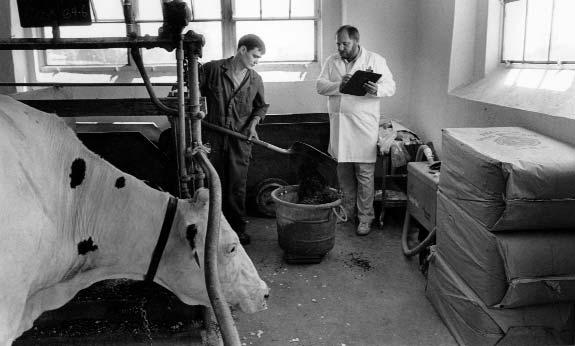

In1986,the Center for Animal Health and Productivity (CAHP) is established.The Center has three main functions:graduate and residency training in animal health and productivity;development and refinement ofa computerized diagnostic and herd health management information system;and field investigations and “on farm”applied research programs.In 1989,ground is broken for a new building which is completed in short order.

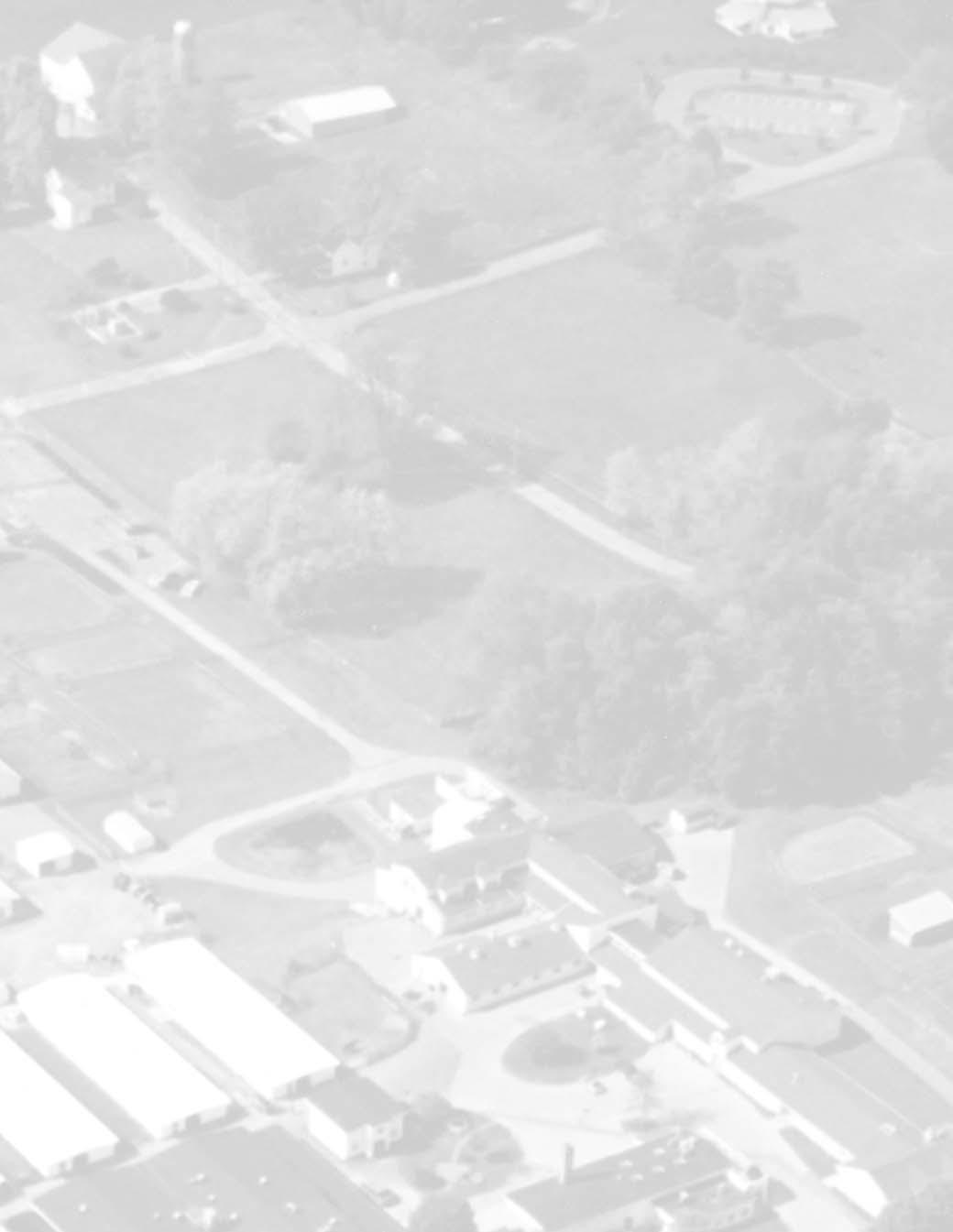
BELLWETHER 53 31
Dr.Charles F.Ramberg, Jr.,V’64, director of CAHPat its inception.
Dr.William Chalupa,a member ofCAHP, supervises a student in ration formulation.
Dr.David Galligan ofCAHP.
In 1989,New Bolton Center had a Day at the Races in Saratoga. During the four years ofthis event almost $250,000 was raised for research and equipment.


Evelyn Huntingdon retires in 1990.Evelyn came to New Bolton Center in 1966 to work in the admissions office.Evelyn was the “frontline”ofthe Widener Hospital.Since her retirement,Evelyn comes to NBC once a week to sell a great assortment ofNew Bolton Center hot and cold weather shirts to benefit the Center and the School.

Drs.Soma
and Sweeney headed up a team that studied the effects offurosemide on the racing performance ofhorses.They determined that the diuretic improves performance in horses with exercise-induced pulmonary hemorrhage (EIPH).The paper published by the team created a stir in racing circles.Other members ofthe team were Drs.Susan J. Holcombe,V’90,Abby Maxson, V’90,Pamela Spencer,Joseph H. Thompson.


32 BELLWETHER 53
Dr.Eric Tulleners introduces laser surgery at New Bolton Center.The program is one ofthe first in a veterinary school.
1990 Day at the Races guests Mrs.Sally Hill, Mrs.Betty Moran,Dean Andrews, Mrs. Annie Jones, Mrs. Bettina Jenney
Dr.Lawrence Soma,V’57, and Dr.Corinne Sweeney look at an equine bronchial tree.
In 1990 the





BELLWETHER 53 33
Connelly Intensive Care Unit/ Graham French Neonatal Section opens.
Intensive care unit,a group ofstalls accessible by monorail.
Busy neonatal unit.
Dr.Jonathan E.Palmer,V’77, checking a patient.
Treatment area in the ICU.
Dr.Allam offers Creme Fraiche champagne during the naming ceremonies for the nursing station in the ICU building – the Creme Fraiche Nursing Station.Creme Fraiche, owned by Betty Moran,won the Belmont Stakes in 1985.The gelding retired from racing in 1989 with winnings of$4,024,721 in 64 starts.



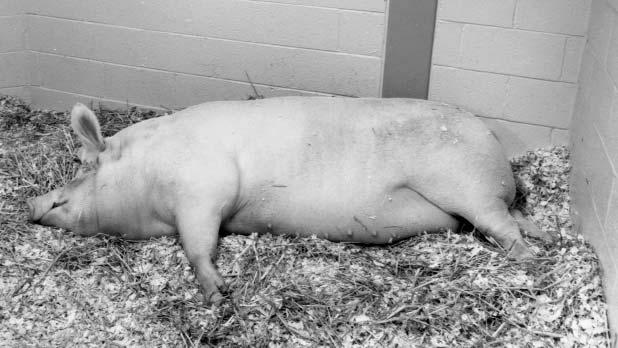


34 BELLWETHER 53
Inside the nursing station.
Some other ICUpatients.
In the summer of1992,the long awaited Jeffords
Treadmill opens.The 2,000 square foot building encompasses a large,two-story space,two stalls and a laboratory.The centerpiece is the high-speed treadmill, enclosed in “bullet-proof” polycarbonate;the treadmill can attain a speed of37mph.
In1992,New Bolton Center’s pathology laboratories become part ofthe comprehensive mammalian diagnostic laboratory system established by the Animal Health and Diagnostic Commission ofthe Commonwealth ofPennsylvania.




The Weaver Barn, located at the Hofmann Center,is renamed and dedicated the Dorothy Russell Havemeyer Barn in April 1992.The 19th century bank barn was renovated to house an equine reproductive and physiologic research facility.

Members ofthe Section ofReproduction and Havemeyer Trustees: Dr.Wolfgang Kähn, Dr.Robert Kenney, Gene Pranzo and Roy Tarlow,trustees,Dorothy Havemeyer Foundation, Dr.Sue McDonnell, Dr.Charles Love, Karen Sole, Dr.Richard McFeely, Dr.Patricia Sertich.
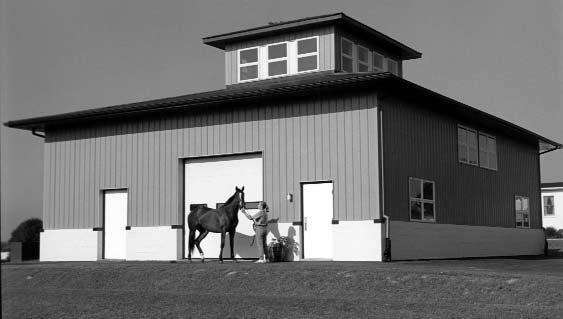
BELLWETHER 53 35
Jeffords Treadmill.
A quiet moment.
Nuclear scintigraphy is added to the diagnostic arsenal.The program is under the direction of Dr.Michael Ross. Shown here are Dr.Ross and Kimberly Buchanan.

ThePennsylvania poultry industry,with funding from the Pennsylvania Department ofAgriculture and the USDA,mounts a pilot program to reduce the number of eggs infected by Salmonella enteritidis.The Cooperative Poultry Diagnostic Laboratory at New Bolton Center is one ofthe study participants.Over the course ofthe study thousands ofeggs are broken and cultured for the organism.Drs.Charles Benson,Robert Eckroade and Sherrill Davison participate in the Salmonella studies which over the years involve many aspects ofSalmonella infection and methods ofreducing or eradicating the organism from a farm.Based upon the extensive data collected at New Bolton Center the Salmonella Research Center (SRC) is established in 1996.

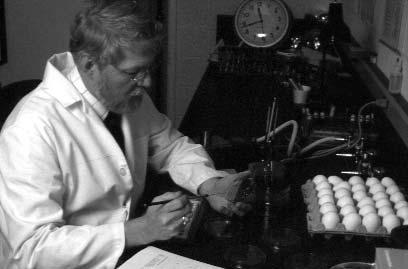


36 BELLWETHER 53
Dr.Eric Tulleners shows a laparoscope,one oftwo added in the fall of1992,to enhance the hospital’s short procedure capabilities.
Dr.Charles Benson
Dr.Sherrill Davison.
Dr.William Boucher dies in January of1993.Dr.Boucher served on the faculty from 1940 until 1981.He served as chief ofmedical service,New Bolton Center, from 1967 until 1979. Beginning in 1940,and continuing until 1968,he was in charge offield service.He received the Lindback Award for Distinguished Teaching in 1981. In 1985,the School honored him by naming the field service the William B.Boucher Field Service.


In1994 “A Weekend in Old Saratoga,”a group ofcarriage enthusiasts,organizes a benefit for New Bolton at Saratoga. Activities include parties,carriages at polo and a gala “An Evening in Old Saratoga.”During the eight years the organization sponsored the New Bolton Center benefits,more than $800,000 has been raised for New Bolton Center projects.


Mrs.Doris Boucher is honored by the PVMA for her support of the Penn veterinary students.She and her husband opened their home to students – good food and lively discussion could be found at the Boucher home.Doris also baked and sold cookies with proceeds going to the Boucher Scholarship Fund.

BELLWETHER 53 37
Mrs.Irene Landan (l) and Mrs.Beverly Ensor present the check from An Evening in Old Saratoga to Dean Alan Kelly in 1994.
In 1994,one ofthe diagnostic laboratories at New Bolton specializes in toxicology as part ofthe Pennsylvania Animal Diagnostic Laboratory System established by the Commonwealth. Dr.Robert Poppenga,a toxicologist,joins the faculty.





Dr.Poppenga explains poisonous plants to Representative Joseph Pitts.
In September 1995,the School holds its first Open House in many years at New Bolton Center.The event is a huge success with close to 8,000 people attending.One ofthe main attractions is six-horse Percheron hitch. Shown here are Mr.Rovenolt (whip) and LeRoy Bruce on the passenger seat.
Dr.Richard McFeely retires after 30 years at New Bolton Center. Dick McFeely joined the faculty in 1966 as assistant professor of animal reproduction. He was appointed full professor in 1975. From 1968 to 1973 he served as chief,Section ofReproduction,followed by two years as chiefofstafffor the large animal hospital.In 1975,he was appointed director ofthe hospital,and in 1976,assistant dean for New Bolton;he served in those positions until 1987.During that period he also served as acting chair for Clinical Studies NBC for two years.Dr.McFeely received the Norden Distinguished Teaching Award in 1977 and was named PVMA Veterinarian ofthe Year in 1988.

38 BELLWETHER 53
Rob Sigafoos, farrier at New Bolton Center, shows the Sigafoos Polymer Shoes at the 1996 Open House.
During the summer of1995, construction begins on Pennsylvania’s first solar dairy.


In October 1996 the Marshak Dairy is dedicated.The structure covers 35,000 square feet and includes free stalls,tie stalls,milking parlor, and offices.The dairy complex includes a heifer barn and a manure treatment and storage facility.

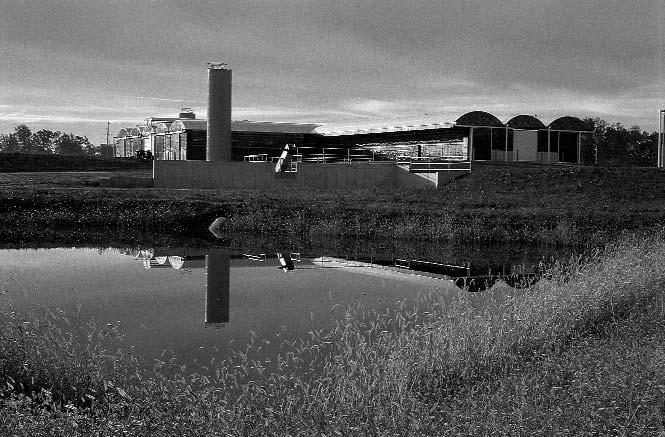



BELLWETHER 53 39
Pennsylvania Secretary ofAgriculture Charles Brosius addresses the guests, Dean Kelly and University President Judith Rodin in the background.
Mr.Richard G.Wood,Wawa,Inc., Dean Kelly, Dr.Marshak, Angela M. Werley,Pennsylvania Dairy Princess.
Dr.Kelly, Mrs.Barbara Hafer,State Treasurer, Dr.Marshak and Dr.Allam.
InSeptember 1997, the School becomes the beneficiary ofthe American Gold Cup. Mark and Lila Allam are honored.





Leroy Bruce,New Bolton Center’s farm manager since 1952,retires after 50 years ofworking for the University.In 1946,Leroy began his career as a farm employee at Bolton Farm where his father was farm manager.When he died,Leroy was appointed manager ofBoltonFarm.He supervised the move to Chester County ofthe registered Guernsey dairy herd,farm equipment,and other possessions.
Fish farming arrives in 1998 at New Bolton Center. Fingerling hybrid striped bass are raised in specially constructed cages that are placed in the renovated and deepened Harnwell Pond.The program is part ofa study funded by the Delaware River Port Authority. Dr.Nunamaker oversees the pond project.


40 BELLWETHER 53
George Pournaras is honored at his retirement party. Dr.Soma presents a plaque while Dr. Raker looks on.
In the M*A*S*H Tent at the Gold Cup.
Dr.Charles Reid, the first equine radiologist,retires.Dr.Reid came to Penn in 1963 as a research associate in radiology.He chaired the radiology department at New Bolton Center since 1981.Dr.Reid is a revered teacher and he received the Lindback Award for Distinguished Teaching in 1978.


In1998,an anonymous alumni donor contributes $600,000 for the renovation ofthe dormitory. Student rooms are rewired and refurbished,a new air conditioning/heating system is installed and the student kitchen is brought upto-date.The building is ready for occupancy in early 1999.

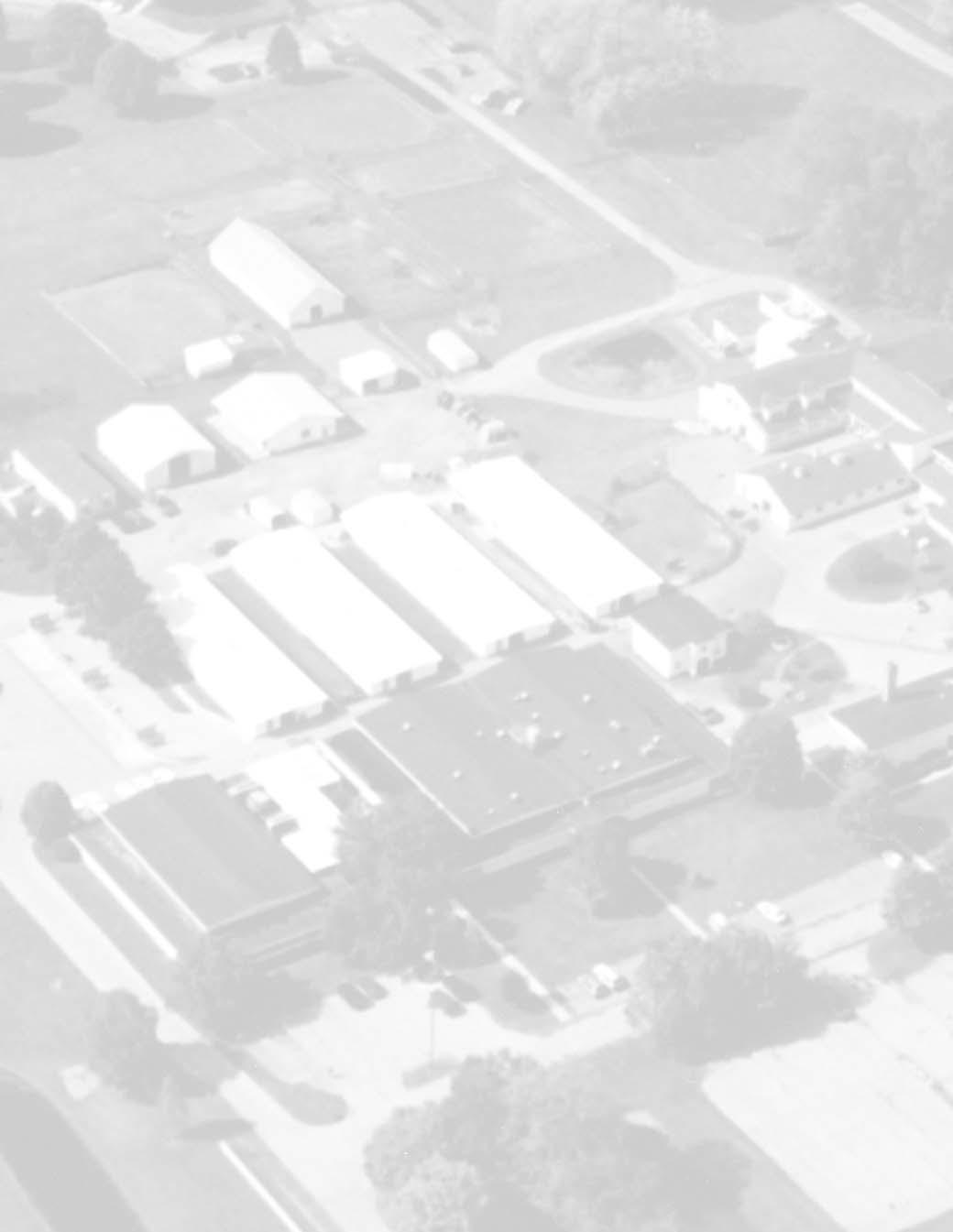
BELLWETHER 53 41
Lila and Mark Allam, identified with New Bolton Center and its ascendency as no other couple,die within a few weeks ofeach other in the spring of1998.
InJune 1998,the Richard S.Reynolds,Jr. Comparative Orthopedic Research Laboratory is dedicated.The new laboratory is named as a tribute to Richard S.Reynolds,Jr.,a former University Trustee.Housed in a 2,800 square-foot addition to the C.Mahlon Kline Orthopedic and Rehabilitation Center,it includes a mechanical testing facility,a computer and microscope viewing room,a bone morphology unit and an orthopedic engineering and machine shop.

Attending the dedication are members ofthe Reynolds family,(l to r) Mrs.Julie Swords, Ms. Julia Swords, Mr.David Reynolds, Mrs.Dorothy Brotherton, shown here with Dr.Kelly and Dr. Nunamaker.


January 2000, Eric Tulleners dies.Eric did his surgical residency at New Bolton Center.Appointed a lecturer in 1981,he was promoted to assistant professor of surgery,becoming the Head ofFood Animal Surgical Services in 1982.In 1986, Dr.Tulleners became the Head ofthe newly-founded Laser Surgical Services and in 1991,was named Chief ofthe Section ofSurgery. He was named the Lawrence Baker Sheppard Associate Professor of Surgery in 1993,and attained the rank ofProfessor in 1998.Dr.Tulleners was a beloved and accomplished teacher and an endowed scholarship in his memory was established through contributions from faculty,residents and students.
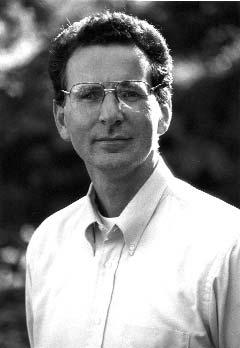
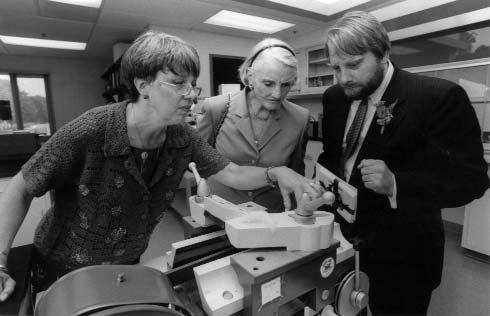
In October 1998,the School dedicates the Margaret McGrath Rockefeller Laboratories in Animal Reproduction and the Marion Dilley and David George Jones Laboratories in Animal Reproduction.The laboratories are major components ofthe School’s Center for Animal Transgenesis and Germ Cell Research.

42 BELLWETHER 53
Judy Lloyd,research assistant,and Mrs. Georgiana Ducas and Mr.Glenn Pew look at histology equipment in the new laboratory.
The New Bolton Center carriage, Bruce Rappoport,whip,and Dean and Mrs.Kelly, passengers for a carriage ride.
A group ofelephants comes ofNew Bolton Center.The radiology room is just large enough to hold all three – the patient,a youngster,and her two constant companions,two adult elephants.
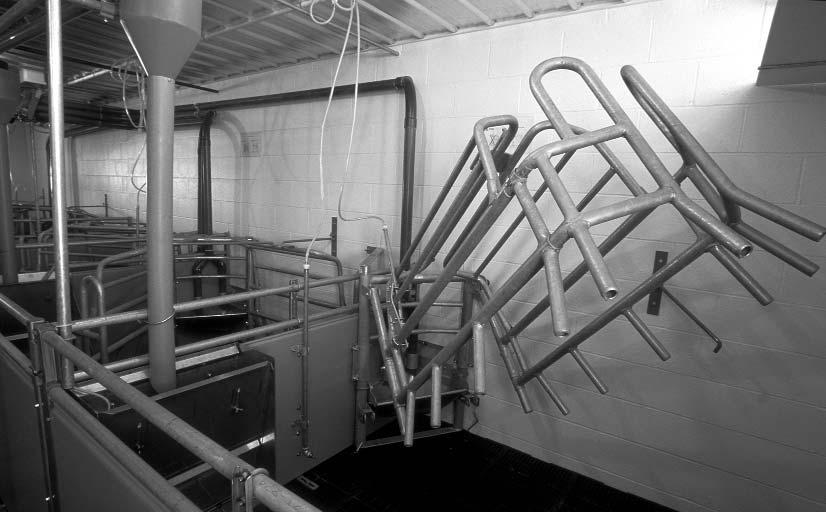

Anew
swine teaching and research facility opens in January 2001.The facility,a first of its kind in the U.S.,incorporates novel technologies imported from Europe for animal comfort, animal feeding,and nutritional management.



BELLWETHER 53 43
Loose-housing area.
A farrowing crate in raised position.
Dr.Tom Parsons,V’86, State Senator Bell and Associate Dean for New Bolton Center, Bruce Rappoport at the unit’s open house.
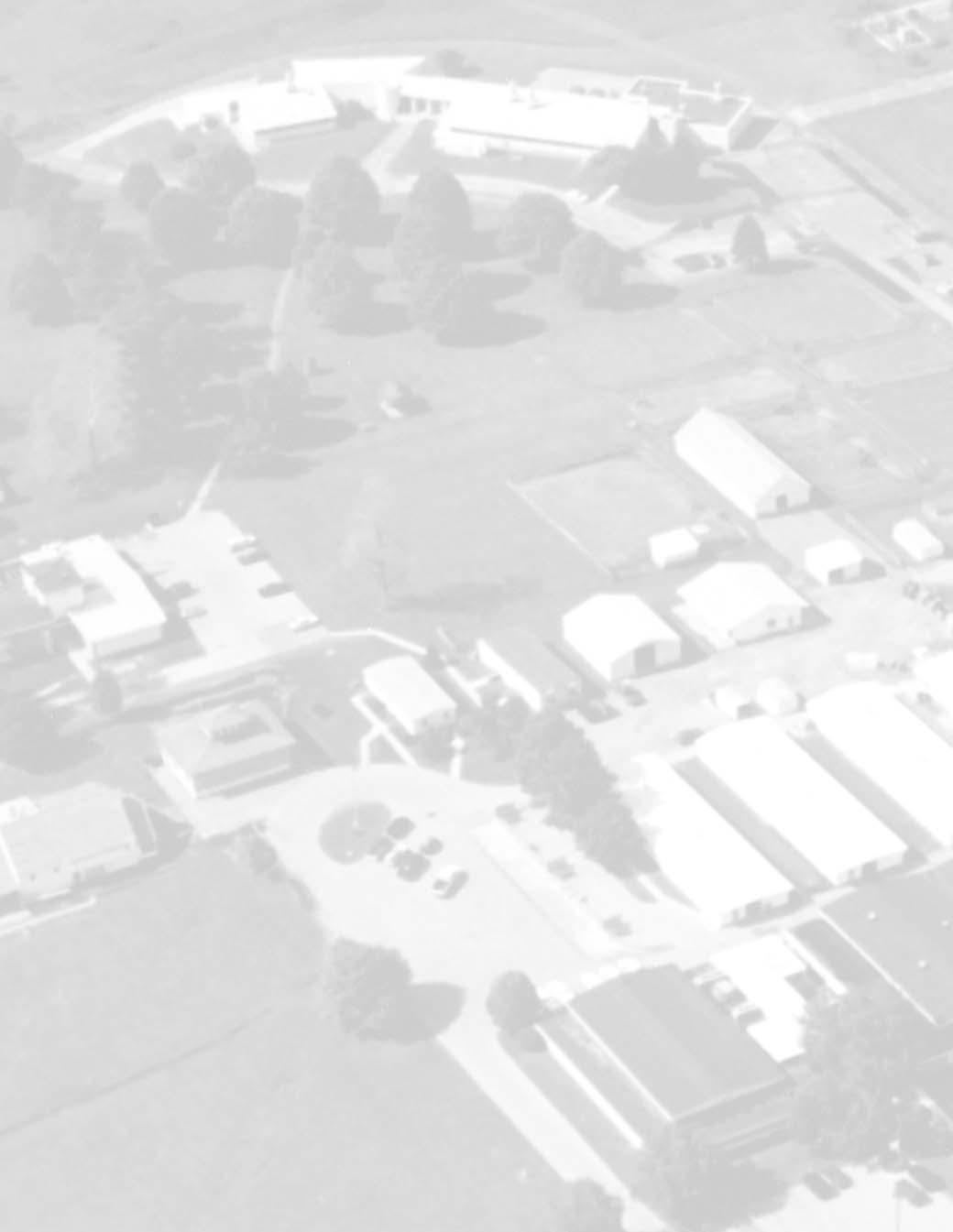




44 BELLWETHER 53
Dr.Eric Birks explains building plans to Mrs.Elizabeth Moran
Dr.Charles Raker,Allaire duPont, Ellen Moelis.
Herbert Moelis,Betty Moran, Christine Connelly
Pat King,Leonard King,Herbert Moelis,Allaire duPont,Betty Moran, Ellen Moelis,Irene Landan,Roy Jackson,Gretchen Jackson.
Ground is broken for the Scott Equine Sports Medicine Building in March 2001.
Theestate ofMrs.Georgia Hofmann,a well-known owner and breeder of Thoroughbred race horses,funded The Georgia E.and Philip B.Hofmann Professorship in Equine Medicine and Reproduction.Mrs.Hofmann died in November 1999 at the age of91;her husband,Philip B.Hofmann,died in 1986.


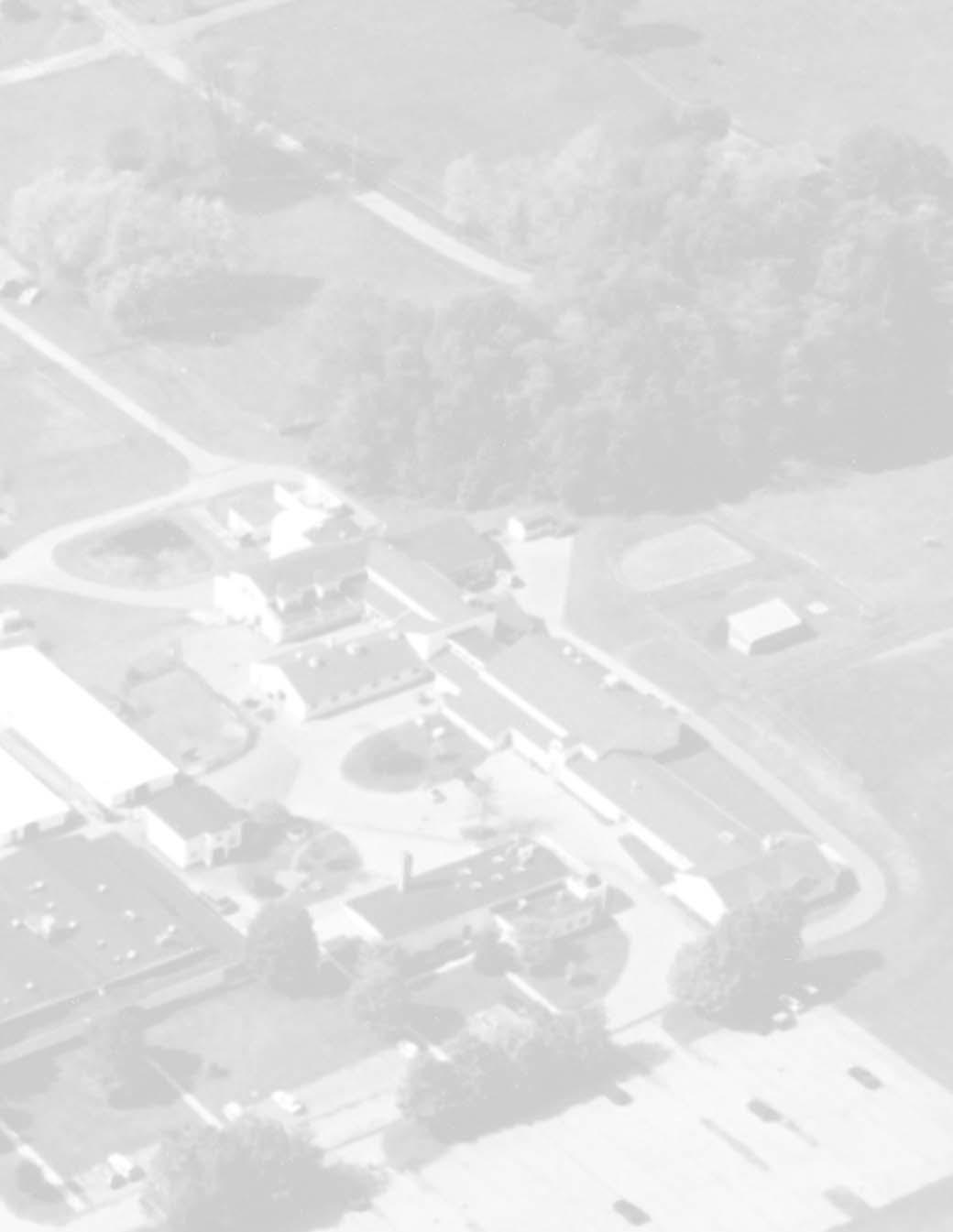
TheFairchild Aquaculture Laboratory is dedicated in April,2002.The 2,500 square-foot-building has 12foot ceilings and is equipped with airhandling and exhaust systems to control airflow.It accommodates four groups of four 330-gallon tanks,each five feet in diameter and two feet deep.Each group oftanks has its own filtration and water system.There is also a small laboratory for on-site testing ofwater samples.
Dr.Jill Beech,V’72 is appointed the first Georgia E.and Philip B. Hofmann Professor in Equine Medicine and Reproduction.
June 29,2002
TheScott Equine Sports Medicine Building is dedicated and a gala dinner celebrating New Bolton Center’s 50 year anniversary is held.

Mr.Alfonso Jackson, Minority Business Development Agency,US Department ofCommerce, Dr.Leon Weiss, Mr.Robert Fairchild, Mr.Manuel Stamatakis near one ofthe tanks in the Fairchild Aquaculture Laboratory.

BELLWETHER 53 45
Dr.James Orsini and Mrs.Kathleen Crompton.
A New Bolton Center Chronology
1952 Purchase of220 acres in southern Chester County announced by Dean Kelser.
Mark W.Allam,V’32,appointed acting dean upon Dr. Kelser’s sudden death.
1953 Dr.Allam appointed eighth dean ofSchool ofVeterinary Medicine.
Cement block building constructed at New Bolton Center to provide,exam room,surgery,recovery stall,pharmacy, diagnostic lab,and four research laboratories.
Field service moved to New Bolton Center from Media.
Department ofPreventive Medicine and Hygiene created at New Bolton Center.
Poultry Diagnostic Laboratory opened at New Bolton Center with Dr.George Sperling as director.
1954 Dr.Charles Hollister appointed director ofNew Bolton Center
1954 Official dedication ofNew Bolton Center.
1956 Robert R.Marshak,D.V.M.joins faculty.
Dr.Monica Reynolds receives School’s first NIH grant.
1958 Major fundraising effort begins for dormitory and hospital buildings at New Bolton Center.
1961 Groundbreaking for hospital and dormitory building
1962 Murphy Laboratory for mastitis research decidated.
1963 Comparative Leukemia Studies Unit established.Dr.Robert Marshak is principal investigator.
1964 Hospital for Large Animals dedicated.
1965 Vansant Dormitory dedicated.
1965 Manor house on campus refurbished and named Allam House.
1966 Dr.William Donawick begins research on valve replacement surgery which later leads to interspecies heart transplantation to study mechanisms ofrejection.
1967 Dr.Charles Raker named Lawrence Baker Sheppard Professor ofSurgery – first endowed professorship in any veterinary school.
1969 Georgia and Philip Hofmann Research Center for Animal Reproduction dedicated.
1970 Alarik Myrin Memorial Research Building dedicated.

1973 Mark W.Allam retires.Robert R.Marshak appointed dean.
1975 Dr.John T.Alexander used the arthroscope for diagnostic purposes.
1975 Endometrial biopsy service in mares offered to horse owners by New Bolton Center.
1976 Pennsylvania Embryo Transfer Service (PETS) established at New Bolton Center.
Lynne Klunder in Dr.McFeely’s laboratory sexes first bovine embryo shortly after conception.
C.Mahlon Kline Orthopedic and Rehabilitation Center dedicated.
1977 Allam House Fund established through the generosity of David George Jones.
1979 First swine unit opens.
1980 Major addition to hospital completed – renamed George D. Widener Hospital for Large Animals.
1981 Virgil – first calfborn as a result ofin vitro fertilization.
1982 Dr.Nunamaker begins using the external fixator to stabilize fractures in horse’s legs.
Parenteral nutrition for calves developed at New Bolton Center.
1983 World’s first twin calves born in Lancaster County from in vitro fertilization at the New Bolton Center laboratory of Dr.Brackett.
Poultry Diagnostic Lab at New Bolton Center identifies virulent form ofavian influenza virus in Pennsylvania flocks. Pacemaker implanted in Bucky the horse.
1984 Equine embryo transfer service established at New Bolton Center.
Drs.Moyer and Nunamaker receive largest grant in Thoroughbred Racing history from NY division ofHorsemen’s Benevolent And Protection association to study bucked shins and relationship to track surfaces.
First neonatal unit opens at New Bolton Center.
1985 Diagnostic ultrasound introduced at New Bolton Center by Dr.Virginia Reef.
Ground is broken for the Connelly Intensive Care Unit/Graham French Neonatal Section.
Dr.Raker retires.
1986 Center for Animal Health and Productivity created at New Bolton Center.
External fixator receives a patent.
First paper on plate luting published – an internal fixation technique to repair broken leg bones in horses.
46 BELLWETHER 53
1987 Robert R.Marshak retires as dean.Dr.Edwin J.Andrews, V’67,appointed dean.
Laser surgery introduced at New Bolton Center.
Ground broken for Stubbs Laboratory

Connelly Intensive Care Unit/Graham French Neonatal Section dedicated.
1988 Stubbs Laboratory dedicated.
1989 Groundbreaking for addition to Center for Animal Health and Productivity building.
New Bolton Center at the Races in Saratoga
GORE-TEX™ vascular graft inserted in horse by Dr.Donawick.
1990 Connelly Intensive Care Unit/Graham French Neonatal Unit opens.
Crème Fraiche Nursing Station in Intensive Care Unit named.
1991 Tenant House renovated and Bruce Heim Antique Furniture Collection dedicated.
1992 Laboratory ofLarge Animal Pathology becomes part ofthe Pennsylvania Comprehensive Mammalian Diagnostic Laboraotory System.
Jeffords Treadmill opens.
Laparoscopy added at New Bolton Center.
1993 Nuclear scintigraphy available at New Bolton Center.
“An Evening at Old Saratoga”benefit and carriages atSaratoga.
Dr.Boucher dies.
Dr.Edwin J.Andrews steps down as dean.
1994 Dr.Alan M.Kelly appointed interim dean.
Toxicology laboratory established.
1995 Construction begins on first solar dairy barn in Pennsylvania.
Dr.Kelly appointed dean.
Open House held at NBC after a hiatus ofmany years.
Tornado damages swine facility,house and machine shop in the farm compound and destroys barn there.
New York Times calls New Bolton the “world’s foremost equine center.”
1996 Salmonella Reference Center established.
Dr.McFeely retires.
Leroy Bruce retires.
Marshak Dairy dedicated.
1997 New Bolton Center beneficiary ofAmerican Gold Cup held at Devon show grounds.
1998 Lila and Mark Allam die.
Dedication ofThe Richard S.Reynolds,Jr.Comparative Orthopedic Research Laboratory
Margaret McGrath Rockefeller Laboratories in Animal Reproduction and the Marion Dilley and David George Jones Laboratories in Animal reproduction dedicated. Fish farming begins in Harnwell Pond.
2001 New swine unit opens.
Groundbreaking for Scott Equine Sports Medicine Building.
2002 Fairchild Aquaculture Laboratory dedicated.
Scott Center for Equine Sports Medicine dedicated.
Endowed Professorships at New Bolton Center
Mark Whittier and Lila Griswold Allam Professor ofSurgery
Georgia E.and Philip B.Hofmann Professor in Equine Medicine and Reproduction
Jacques Jenny Professor ofOrthopedic Surgery
Marion Dilley and David George Jones Professor in Reproduction Medicine
Grace Lansing Lambert Professor ofCell Biology
Charles W.Raker Professor ofEquine Surgery
Lawrence B.Sheppard Professor ofSurgery
Marilyn M.Simpson Professor ofLarge Animal VeterinaryMedicine
BELLWETHER 53 47
Bellwether
University ofPennsylvania School ofVeterinary Medicine
Editor
Helma Weeks
Photographers
AddisonGeary
Adam Gordon
Nick Kelsh
Lynne Klunder
Eugene Mopsik
Frank Ross
Bruce Stromberg
Anthony Wood Writers
E.Jefferies Hathaway,V.M.D.
Robert R.Marshak,D.V.M.
Richard McFeely,V.M.D.
David Meirs,V.M.D.
William Moyer,D.V.M.
Alumni Relations Liaison
Joshua E.Liss
New Bolton Center Liaison
Jeanie Robinson-Pownall
We’d like to hear your praise,criticisms,or comments.Please address your correspondence to:
Helma Weeks
University ofPennsylvania
School ofVeterinary Medicine

3800 Spruce Street
Philadelphia,PA 19104-6010
(215) 898-1475
hweeks@vet.upenn.edu
None ofthese articles are to be reproduced in any form without the permission ofthe editor of Bellwether
©Copyright 2002 by the Trustees ofthe University ofPennsylvania.
The University ofPennsylvania values diversity and seeks talented students,faculty and stafffrom diverse backgrounds.The University ofPennsylvania does not discriminate on the basis ofrace,sex,sexual orientation, religion,color,national or ethnic origin,age,disability,or status as a Vietnam Era Veteran or disabled veteran in the administration ofeducational policies,programs or activities;admissions policies;scholarship and loan awards;athletic,or other University administered programs or employment.Questions or complaints regarding this policy should be directed to:Executive Director, Office ofAffirmative Action and Equal Opportunity Programs,3600 Chestnut Street,Sansom Place East,Suite 228,Philadelphia,PA 19104-6106 or (215) 898-6993 (Voice) or (215) 898-7803 (TDD).
48 BELLWETHER 53
THANKYOU to alumni,friends,staff,and faculty for their many contributions to this issue of Bellwether.Regretfully,not everyone who contributed to New Bolton Center's development could be acknowledged in this issue.
 Hofmann Center Marshak DairySwine Facility
Poultry Diagnostic Lab Farm Equipment/Machine Shop
George D.Widener Hospital Myrin Building
Hofmann Center Marshak DairySwine Facility
Poultry Diagnostic Lab Farm Equipment/Machine Shop
George D.Widener Hospital Myrin Building
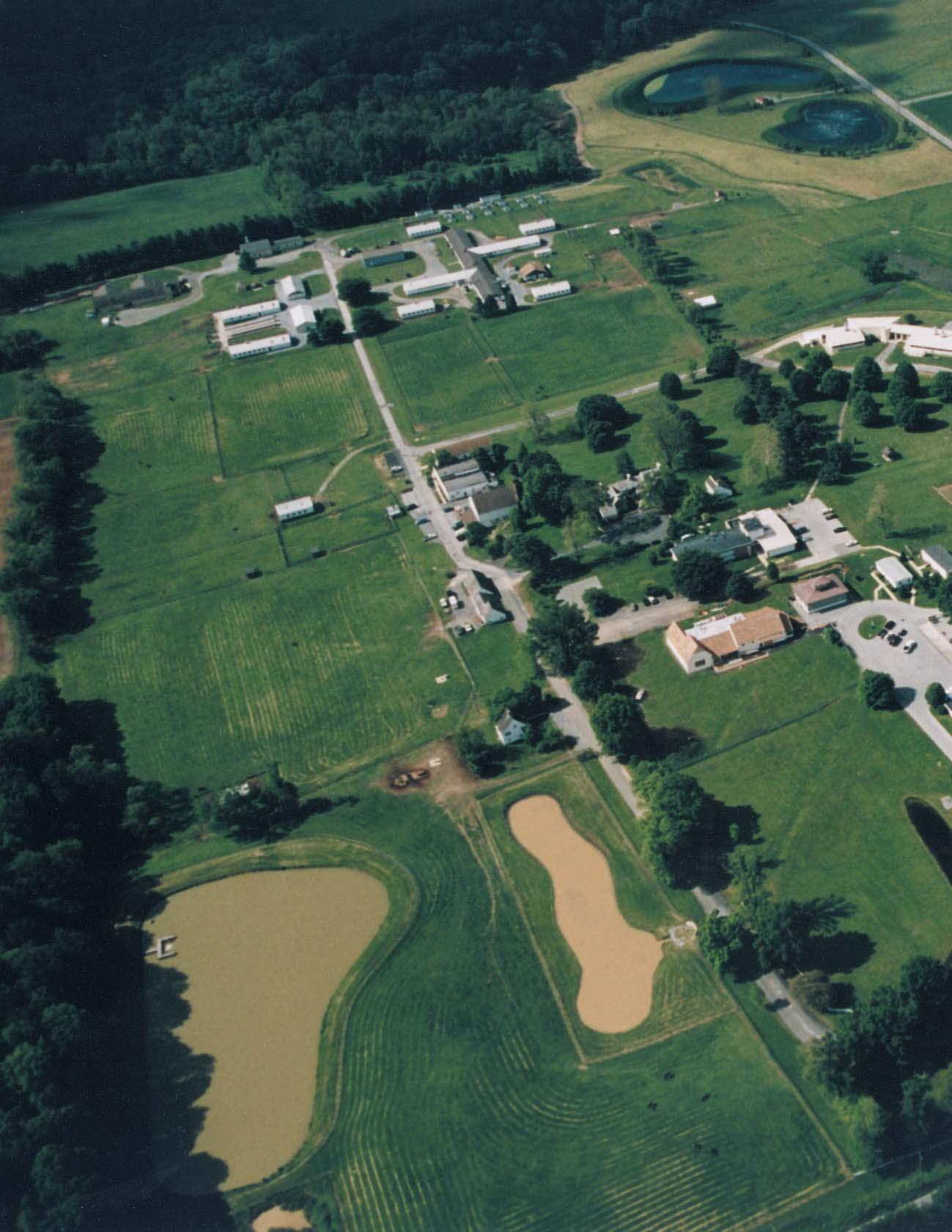
School ofVeterinary Medicine UNIVERSITY OF PENNSYLVANIA ®







































































































































































































 Hofmann Center Marshak DairySwine Facility
Poultry Diagnostic Lab Farm Equipment/Machine Shop
George D.Widener Hospital Myrin Building
Hofmann Center Marshak DairySwine Facility
Poultry Diagnostic Lab Farm Equipment/Machine Shop
George D.Widener Hospital Myrin Building
